
Touropia Travel
Discover the World

10 Most Amazing Destinations in South China
By Mike Kaplan · Last updated on March 4, 2024
China and the United States take up about the same amount of land, but China is home to nearly a billion more people. Navigating this massive country can be an intimidating challenge. But it becomes much more manageable if you break the nation up into smaller pieces.
In the south, you’ll find modern cities, towering karst mountains, matrilineal societies, beautifully preserved ancient villages, death-defying gorges and stunning lakes. Plan your swing of South China right, and you’ll be able to see the very best that the country has to offer.
10. Lugu Lake [SEE MAP]
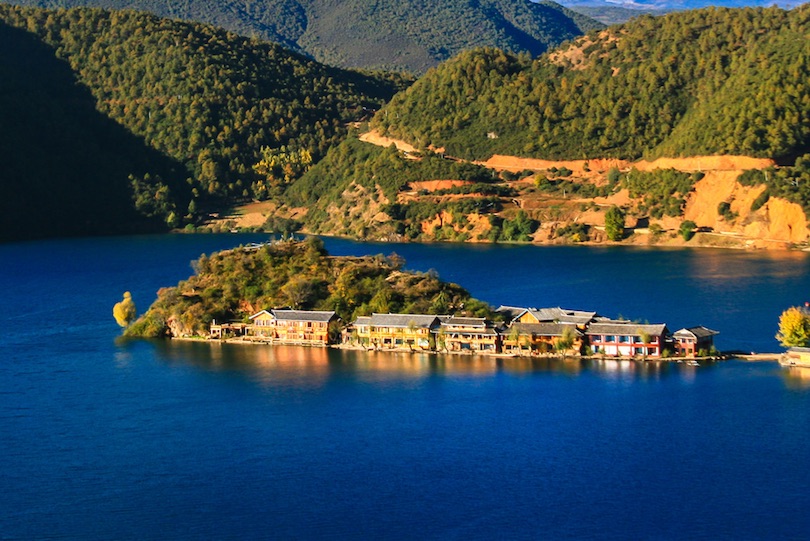
This idyllic lake sits nearly 2,700 meters (9,000 feet) above sea level. To get here, you’ll have to ascend an ancient switchback road, and the first site of the lake will leave you breathless. Forested hills slope out of pristine waters while small towns dot the shores. And Lugu Lake is home to one of the last matrilineal societies on earth.
Luoshui is home to the Mosuo people where children take their mother’s last names, and daughters are preferred over sons. This unique culture draws crowds of tourists, but the trek up to Lugu Lake is worth it.
9. Tiger Leaping Gorge [SEE MAP]
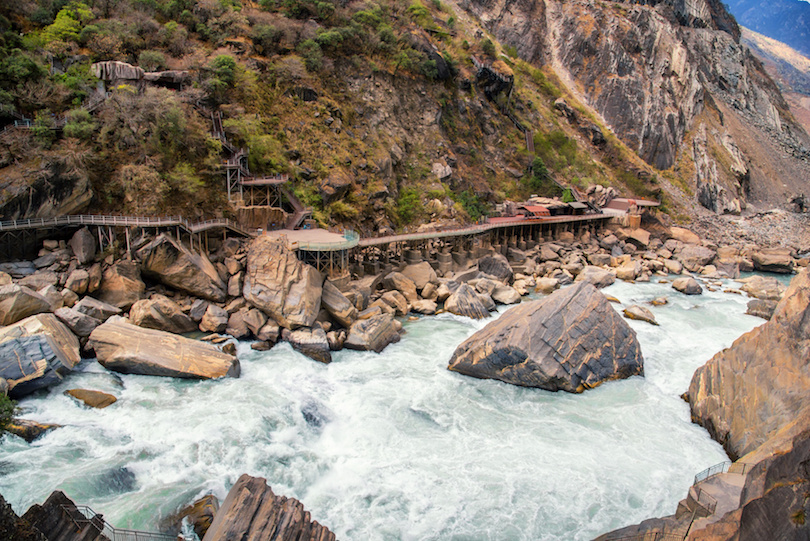
It’s almost 1,000 meters (3,000 feet) from the top of the Hābā Shān Mountains to the rushing waters of the Jīnshā River. And it begs the question — did the river carve this death-defying gorge, or did the mountains rise around it? Either way, this 16 km (10-mile) long river gorge is beautiful every step of the way, but you’ll have to earn it.
The high trail trek will have you stepping carefully over loose stones on the edge of the mountains as you pass locals leading donkeys. Of course, you can always tour the Tiger Leaping Gorge from the low trail on a tour bus if you’re not feeling so adventurous.
8. Macau [SEE MAP]
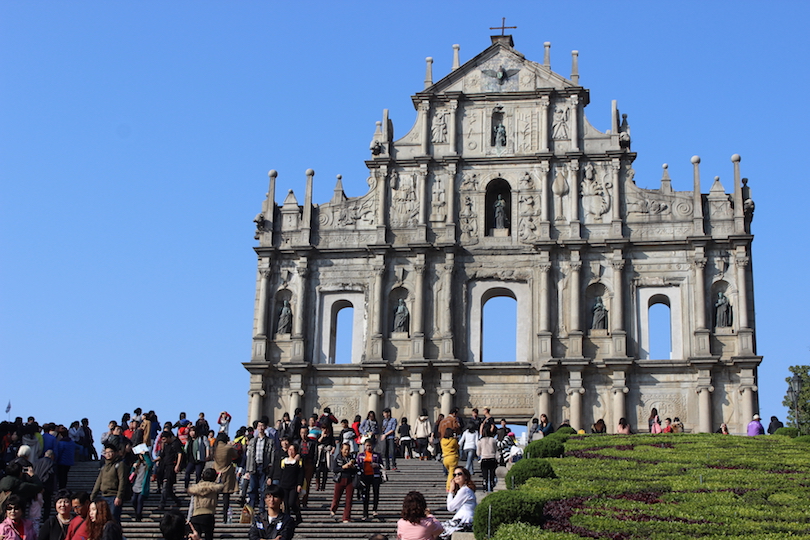
Put on your best clothes to head on out for some glitz in Macau. Often referred to as the Vegas of China, this gambling town has all the glamour of Sin City but with more history.
Macau was a Portuguese colony for more than 300 years, and you can see the evidence on the ground. Ancient Chinese temples rise out of streets covered in traditional Portuguese tiles to create a stunning mosaic of blended cultures. And you’ll find this juxtaposition everywhere. Colonial buildings sit right next to flashy casinos and new boutiques. You can choose to dine on traditional Chinese fare, Portuguese food or a fusion of the two known as Macanese.
7. Lijiang Old Town [SEE MAP]
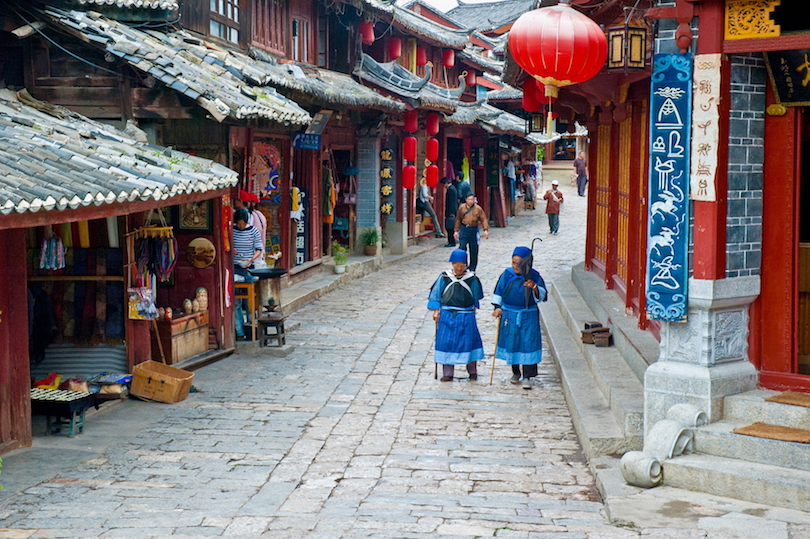
Lijiang Old Town is one of China’s four best-preserved ancient cities. Cobblestone streets lead you over stone bridges as babbling canals drive waterwheels. After taking some time to admire the giant goldfish in the canals below, you’ll notice the ancient streets are now lined with shops, family-owned hotels, restaurants and bars.
But the city has lost none of its old world charm. Four main streets lead out of Sifang Square at the center of town, and they connect a network of laneways with over 350 bridges. Hop over the rain bridge, stone arch bridge, slab bridge and plank bridge to get to sites like Mu’s Residence, the Wangu Tower and the Black Dragon Pool that perfectly reflects the snowcapped mountains in the distance.
6. Dali [SEE MAP]

Not too long ago, Dali was a backpacker hangout. It was sort of a rite of passage for backpackers in western China to spend a couple of weeks hanging out on Ěrhǎi Lake. But now dreadlocked westerners have been replaced with the rapidly growing middle class travelers of China herself.
While domestic tourism has boomed in Dali over the years, the local Bai population still makes daily life in Dali extremely interesting. And there is plenty to discover in the mountains above Dali’s Ěrhǎi Lake. Or you can simply choose to join the Chinese tourists with Bai flowers in their hair by eating, drinking and partying.
5. Guilin [SEE MAP]
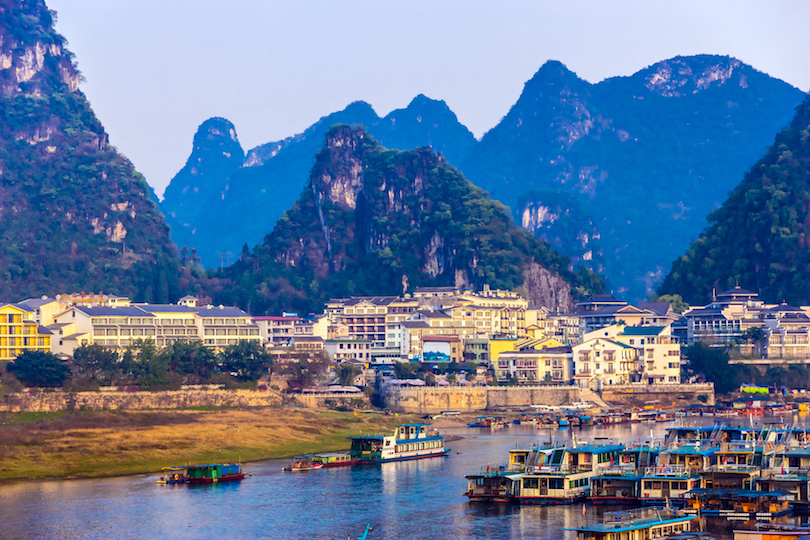
A centuries-old medieval moat awaits you in the city of Guilin. Local boats still travel the moat and other waterways connecting the city’s two lakes — Shanhu and Ronghu. The sun and moon temples light up at night on the shores of Lake Shanhu to help light up the dramatic limestone karst mountains that crown the landscape.
This beautiful but aging city serves as the gateway to Guǎngxī. It’s full of modern amenities, and plenty of the locals speak English. Guilin is a beautiful rest stop where you can plan your Li River cruise and journey deep into scenic Guǎngxī.
4. Kunming [SEE MAP]
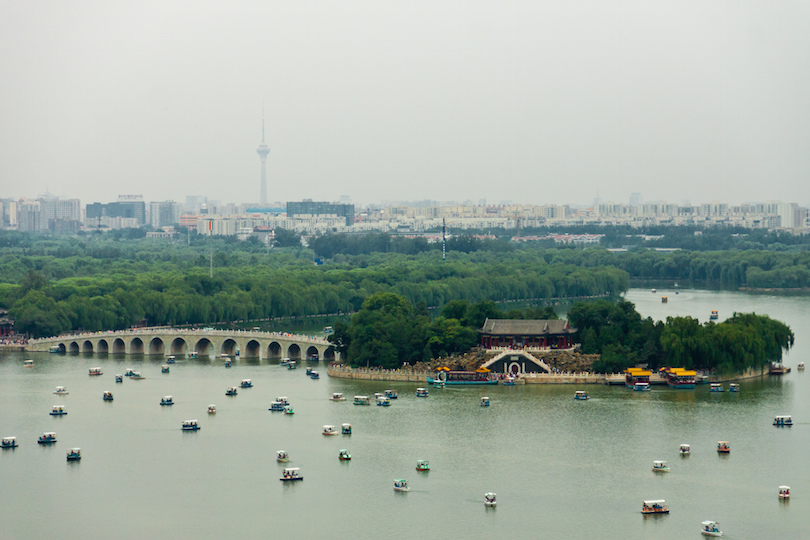
Kunming is a laid-back city on the Dianchi Pool. Often referred to as one of China’s most liveable cities, tourists will find Kunming incredibly relaxing. And this enjoyable city is near some beautiful temples and National Parks like the Stone Forest where limestone karsts provide a stunning landscape.
The city’s Buddhist Bamboo Temple is full of beautiful statues while the Tàihuá Temple towers above the Dianchi Pool. But, like many Chinese cities, old neighborhoods are being torn down for modern stores, and traffic is becoming a new problem. Yet Kunming still retains its friendly, laid-back vibe.
3. Longji Terraces [SEE MAP]
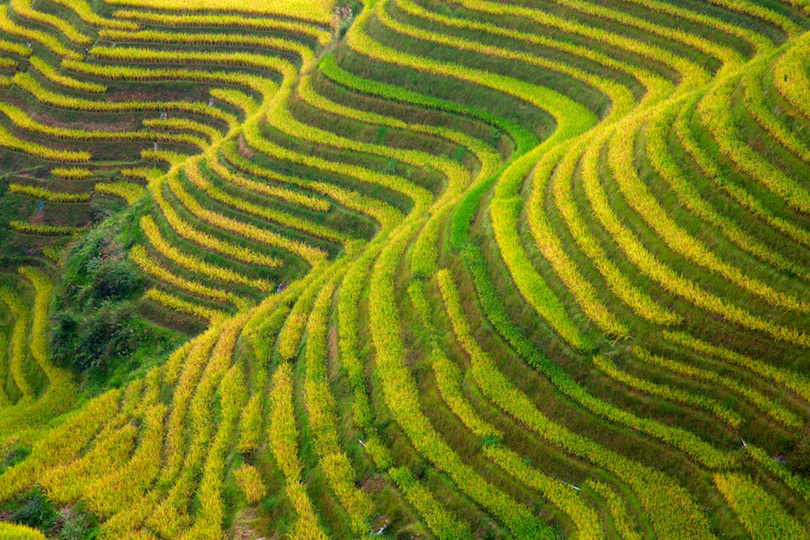
There is something absolutely spiritual about staring at rice terraces. The lines carved into the earth are smooth and mathematical yet feminine. And all this earth carving artwork produces China’s carbohydrate staple — rice. Something primal, deep down inside, makes you feel good and at peace with the landscape that you’re marveling at.
The pools on Longji Terraces softly reflect the sun while the ears of the rice plant glow yellow during harvest time. The rice terraces are like a giant ampitheater taking up land farther than the eye can see.
2. Yangshuo [SEE MAP]
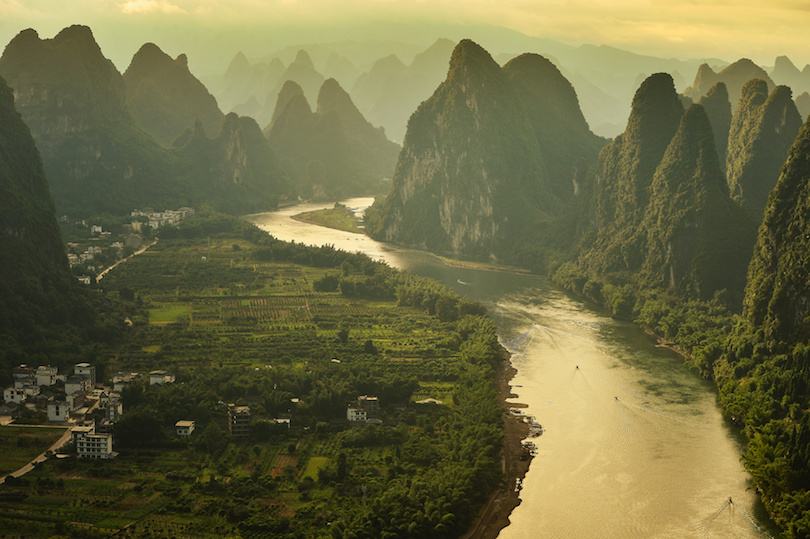
Step into another world in Yangshuo County. This beautiful stretch of land is an ethereal landscape of unbelievable karst mountains. You’ll be floored by the dramatic Green Lotus Peak and even more impressed that there’s a hiking trail to the top.
The main tourist town of Xijie has grown quite a bit in recent years. You’ll hear plenty of loud club music as the sun sets, and you’ll have to battle your way through a maze of selfie sticks to get about town, but you can still escape to quiet rooftop bars to take in the serenity of the surroundings. As the day breaks, you can take dreamy bamboo raft rides or cycle through magical valleys out of Yángshuò town as the landscape grows more surreal.
1. Hong Kong [SEE MAP]
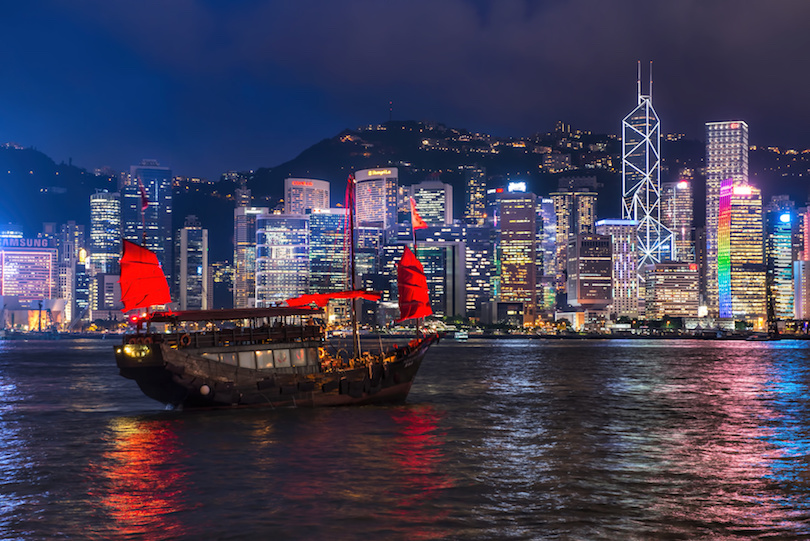
Hong Kong is 70% mountains and country parks, and its neighborhoods are scattered amongst islands. This modern city has every comfortable amenity in the books and is a very easy, yet expensive, travel destination. The public transportation systems are incredibly smooth, and they will take you to adventures like hiking lonely islands or kayaking under volcanic sea arches. And this city is one of the world’s culinary capitals where Cantonese, Sichuanese, Japanese and French cuisines collide.
There’s plenty of high-end shopping at glitzy boutiques, and the nightlife keeps bumping until the morning hours. And, to cap it all off, Hong Kong is an incredibly safe city for tourists.
See also: Where to Stay in Hong Kong
Share this post:
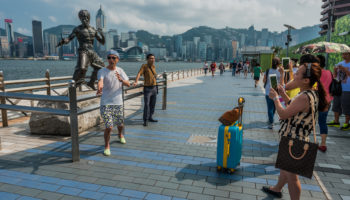
17 Top Tourist Attractions in Hong Kong
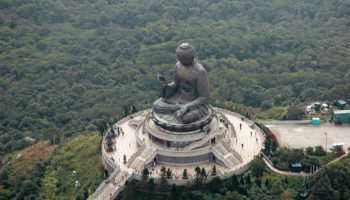
7 Best Day Trips From Hong Kong
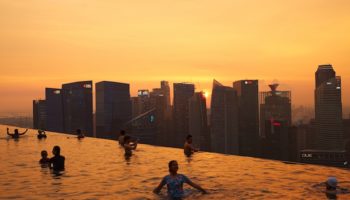
25 Best Cities to Visit in Asia
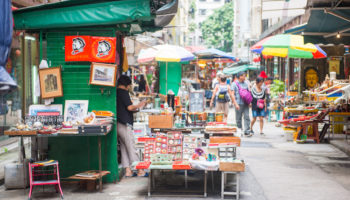
Where to Stay in Hong Kong: 8 Best Neighborhoods
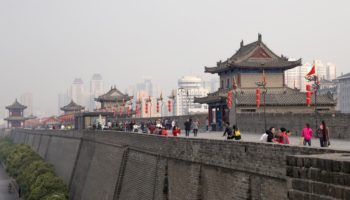
12 Best Things to Do in Xi’an, China
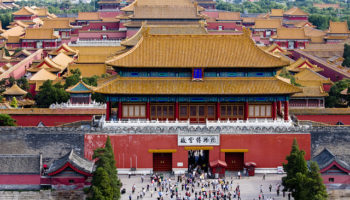
10 Top Tourist Attractions in Beijing
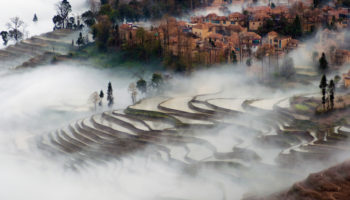
14 Most Beautiful Small Towns in China
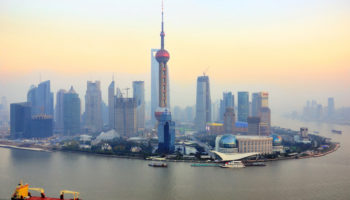
17 Best Places to Visit in China
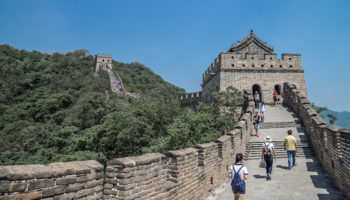
9 Best Day Trips from Beijing
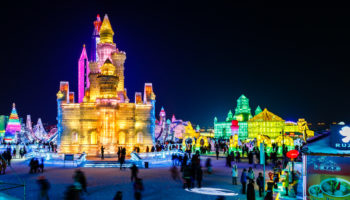
10 Most Amazing Destinations in North China
Reader interactions, leave a reply cancel reply.
Your email address will not be published. Required fields are marked *
This site uses Akismet to reduce spam. Learn how your comment data is processed .
Southern China Tours - 10 Best Southern China Tour Packages
Best Places to Visit in Southern China 2024
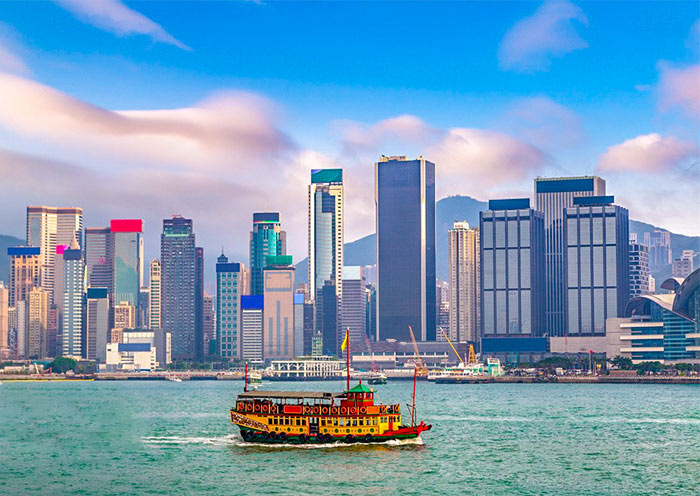
"Excellent Tour, best experience"
"A unique experience despite a difficult context thanks
to an experience team of organisers"
Top Southern China Tours for 2024
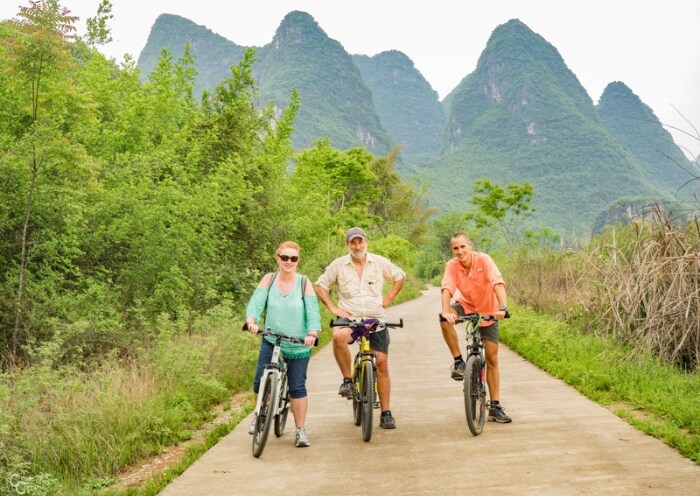
All Southern China Tours (10 Itineraries)
- China Tours from Beijing
- China Tours from Shanghai
- China Tours from Hong Kong
- China Tours from Chengdu
- Southwest China Tours
- Tibet Discovery Tours
- Yangtze River Cruises
- China Great Wall Tours
- Yunnan Tours
- Southern China Tours
- China Panda Tours
- China Family Tours
- Silk Road Tours
- China Group Tours
- Northern China Tours
Latest Southern China Tours Reviews from Our Customers

I'm a Singaporean traveller who booked a private solo tour. I chanced upon AOT after I googled and decided to travel last min. My planner from AOT named Rita was very patient towards all my request and changes, she is knowledgeable and provided excellent advice for my 8 days trip arrangement from Shanghai, Zhangjiajie N Chongqing. Although there were very minor hiccups just like any overseas holiday, it was still a well planned trip.
I would like thank all my tour guides and drivers (师父) for looking after me so well. Special mention to Zhangjiajie Tour Guide named Ms Rita Wang, she looks after her client with her sincerest heart into the smallest details such as eating habits and my lifestyle. (Example: Turning A/C on knowing we Singaporeans can't live without A/C in car & also I don't even have to look at menu to order food becos she knows what I want to eat) Also thank you 杨师父 who tagged team with Rita, he is a very good skilled safe driver and knows how look after me during long haul journey drive inter cities.
I would strongly reccomended anyone who wants to travel to look for Rita or her colleagues from Asia Odyssey Travel.
Lastly, thank you to all whom I've crossed path during my trip. I'm grateful to all people in China for the warm hospitality. 感恩大家的招待和爱。
I left my heart in Zhangjiajie
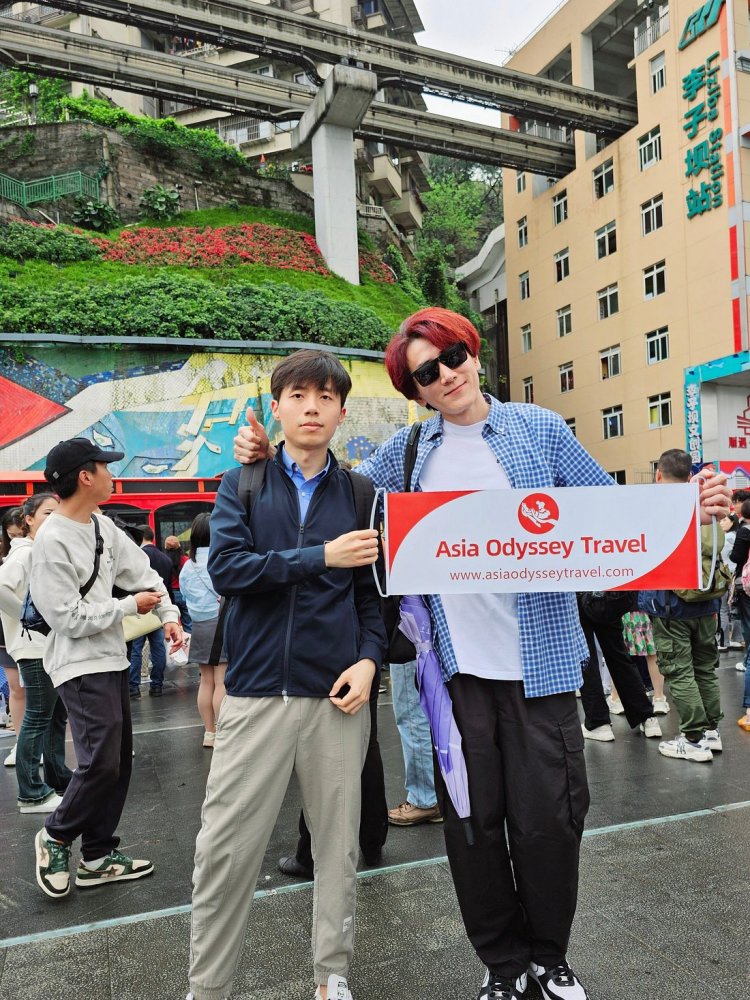
Destination(s): Beijing, Xian, Shanghai, Zhangjiajie
Date of Experience: Apr 06, 2024
Tour Customized by: Rita
You May be Interested in This Tour: 11 Days China Scenic & Cultural Tour in Group (Shanghai Zhangjiajie Xian Beijing)

Destination(s): Beijing, Xian, Shanghai
Date of Experience: Mar 25, 2024
Tour Customized by: Rex
You May be Interested in This Tour: 8 Days Beijing Xian Shanghai Small Group Tour

HELEN HUANG
Date of Experience: Mar 20, 2024
Tour Customized by: Vincent
You May be Interested in This Tour: Customized Tour
Our local experts can design your trip based on your preferences

Warning - You are using an outdated browser. Please upgrade your browser to properly view this website.

- Destinations
- Asia pacific
- Southern china
Southern China travel guide
Guangdong, Hainan and Fujian are among the richest and most developed provinces in China. This is especially true of the coastal regions – and, of course, Hong Kong – which have for centuries been associated with seafaring, trade and overseas settlement. Most ‘Overseas Chinese’ trace their origins to these areas, and many have retained strong links with their ancestral towns and villages.
The geography of Southern China
To the west, Guangxi (technically an autonomous region rather than a province) is less developed and with minority nationalities making up almost 40 percent of the population, it is overshadowed economically by the other coastal provinces. The Guilin region in the north, however, is a favourite tourist destination, home to some of the most beautiful natural scenery anywhere in the world.
These subtropical southern lands differ from the ancient heartlands north of the Yangzi in many respects. Most obviously, the land is different, dominated by verdant green rice fields, with longer summers and milder winters. In terms of language, Cantonese and Fujianese are quite distinct from the northern dialect, Mandarin. Southern Chinese food – long familiar to the rest of the world as ‘Cantonese’ cuisine – is fresher and more subtle than that of the north.
Southern China's tradition of commerce
The idea of commerce is well-established in southern China. Guangzhou, China’s third-largest city, was already an international port in the 9th century, and by the 1500s, when the Portuguese arrived in a showy flotilla, the area had replaced the Silk Road as the trade route of choice into China. Southeast China’s other port of note lacks the historical depth of Guangzhou, but has long had a remarkable entrepreneurial zeal. As a British colony, Hong Kong became the definitive capitalist free-market, no-holds-barred trading centre. Following its return to China in 1997, it remains a fascinating and unique travel destination, as upbeat and dazzling as ever. Across the Pearl River Delta is Macau , until recently a sleepy Portuguese enclave, but these days specialising in Las Vegas-style casinos.
Off the coast of western Guangdong is the large island of Hainan island , with China’s southernmost beaches – fringed by palms and bathed in year-round warmth – now being aggressively marketed to tourists. Further east along the coast, thriving Fujian province offers the old European enclave of Amoy, now called Xiamen . This is one of China’s most engaging cities, with its enchanting island of Gulangyu decked out in colonial era architecture and laced with lazy walks.

Places to visit around Southern China
The entry point into China for many tourists, Hong Kong makes a memorable introduction to the Chinese world. Glamorous, hectic, exciting and spectacular, with fabulous food, nightlife and shopping, this is a place like no other. Read more…
Following in the steps of Hong Kong, Macau has become a Special Administrative Region of China. Its Portuguese colonial ambience and rapidly expanding resort status offer a unique experience in China. Read more…
- Guilin and around
The magical, almost mystical scenery region around the city of Guilin is one of China’s best-known tourist attractions. Wind and rain has eroded the limestone hills into fantastic shapes, with some peaks rounded and some sharply pointed, perpendicular cliffs and trees that sprout from the cracks to bend skyward, this is a dream-like landscape. Read more…
- Hainan island
Historically and geographically out on a limb, for centuries shunned as a miserable place of exile battered by typhoons, Hainan Island has come into its own as a tropical resort destination. Uniquely in China, it basks in year-round warmth, and there are plenty of palm-fringed beaches on which to take advantage of that fact. Read more…
One of China’s most engaging cities, the port of Xiamen has an attractive old centre and a beguiling offshore haven, the island of Gulangyu. Formerly known in the west as Amoy, it became wealthy during the expansive maritime trading years of the Ming dynasty. The port was opened to foreign trade after the Opium Wars, when Gulangyu became a foreign enclave, complete with elegant colonial buildings.
The Old Town is centred on lower Zhongshan Lu, and is a pleasant place to explore. On Siming Nanlu, about 2km (1¼ miles) south, is the Overseas Chinese Museum (Huaqiao Bowuguan), with an outstanding collection of pottery and bronzes gathered with the help of donations from the extensive overseas Fujianese community. There is also an informative section on the diaspora itself.
Gulangyu Island
Occupied by colonial powers until World War II, the island of Gulangyu is the main attraction, a laid-back museum piece of colonial architecture accessed via a five-minute ferry ride. Peace and quiet is a big part of the appeal – there are no vehicles (or even bicycles) allowed, although electric trains trundle slowly along the leafy lanes. The island is also known for its musical heritage; it can claim the world’s highest per-capita piano ownership, and there is a Piano Museum and festival.
Turn left from the pier to see the huge statue of Koxinga, a Chinese patriot who liberated Taiwan from the Dutch in the mid-17th century; the statue stands near the eastern shore of the island. Continue walking along the coast to reach the picturesque Shuzhuang Garden (Shuzhuang Huayuan), beyond which a pleasant sandy beach extends along much of the island’s southern coast.
Ascend Sunlight Rock (Riguangyan), the highest point on Gulangyu, for views across the red-tiled villas and verdant gardens to downtown Xiamen.
Average customers rating

{{_ "pagesAdmin.destinations.overviewCulturalFeaturesIn"}} {{currentName}}
{{_ "pagesAdmin.destinations.overviewViewAllFeatures"}} {{currentName}}
{{_ "pagesAdmin.destinations.overviewHistoricalHighlights"}} {{currentName}}
{{_ "pagesAdmin.destinations.overviewViewAllHighlights"}} {{currentName}}
Places to visit in Southern china
Read more from the travel guide to China
- Top attractions
- Historical highlights
- Cultural features
- Plan your trip
- Top restaurants
- Useful phrases


AN ULTIMATE GUIDE TO SOUTH CHINA
China is a dreamland for many travelers. It is so rich in geography, history, and culture so that many years are not enough to explore it deeply in details. When people visit China, first they look to its most famous landmarks- the Great Wall, Beijing and its Forbidden City, Shanghai, Xi’an’s Terracotta Warriors, Shao Lin Monastery and Guilin. But it is nothing, compared to what China really has to offer. This country is so large, that geographically it can be divided into a few smaller lands, which are quite different from each other. In this article, we will dive into its southern part, or, South China, with everything it can be seen and taste there.
If you’re interested in learning Cantonese, immersing yourself in the culture and lifestyle of South China can provide valuable context and insight into the language. Exploring Cantonese through cultural experiences like this can enhance your understanding and appreciation of the language’s nuances and expressions. There are various ways to learn Cantonese , including language classes, online resources, and language exchange programs, which can all contribute to your language acquisition journey.
So, let’s explore South China together!
Table of Contents
Geographical definition of South China
The Southern part of China is generally everything, which is situated south of Yangtze River. That’s how the Chinese think about this part of their country- they call it “Nan Fang” (南方), which means “South Side” and consider Yangtze (Chang Jiang) River as a divider between the South and the North (although it is unclear whether some big cities like Shanghai, Nanjing, Wuhan, and Chongqing, which are located on Yangtze River, really belong to the South or not).
But the scholars specializing in geography, offer some better definitions of “South China”. They consider many things like the geographical zones, relief, climate, as well as local culture and history. Thus generally what they propose to be “South China”, generally include the provinces of Fujian, Jiangxi, Hubei, Hunan, Guangdong, Hainan, and Guangxi. Some include also Guizhou, and Yunnan, while others define “West China” (which however is NOT the western part of China as a whole- Tibet, Xinjiang and Qinghai- they are completely different parts of the country), including Yunnan, Guizhou, the eastern part of Sichuan, Chongqing, Shaanxi and the southern part of Gansu.

Nature of South China
An endless maze of hills, covered by lush subtropical jungle. Rice fields, surrounded by bamboos and bananas. Curving rivers with small villages on their banks. This is the landscape in most of South China. If you travel from Yangtze River to the South China Sea, or from Fujian to the foot of Tibet, this is the typical view that you will often see on your route. But let’s look deeper into this piece of land.
It is one of the main parts of South China’s image. There is a watershed between Yangtze and Mekong rivers, starting from the interior of the Great Tibetan Plateau. In Yunnan province, this watershed divides into two branches. And the northern branch, which prolongs eastward between Yangtze and South China sea, reaching the plain of Shanghai, is the main “spine” of a large mountainous area, known as “Nan Ling” (南岭)- which means “Southern Hills” (although what is actually included in “Nan Ling” is not clearly determined).
These mountains are not too high and are clustered in groups, with larger plains and valleys between them. The highest peaks reach a little higher than 2000 m altitude, but in general, most of the area is lower than 500 m altitude. And all the mountains are richly covered by wild subtropical rain forests.
Yes, the forests are thick, wild and difficult to walk through. Unless there are some roads and paths, roaming off-road is an extreme and dangerous adventure. Now some of the mountains are turned into national parks and there are well-arranged paths, which is “not so wild and adventurous”, easily accessible by every tourist. But many other mountains remain wild, and hiking in their jungles is really exciting.
I still remember our 3-days trekking in Mt. Chuandiding in Guangdong province. It is a wild hiking route, favorite for many adventure hikers, with a relatively high level of difficulty. The highest peak of the mountain is 1580 m altitude, and we could see clear vertical zoning of the forest. There were lush jungles, mixed with bamboos and banana trees in the low areas. In the middle- just a thick forest, more like the forests of moderate climate areas, but still thicker. And in the high areas, these forests gradually turn into a bush thicket, mixed with grasslands. Finally, we reached the highest peak, where we spent the night camping in our tents.

Karst hills
This is the most spectacular landmark in South China. In fact, it is one of the most famous symbols of the whole country- the maze tower, pillar, and conical hills, with curving rivers between them, bamboos of their banks and exotic fishermen with conical hats on their boats.
Actually, this popular image comes from a certain geographical spot in China- a village on the bank of Li River, near Xingping town in Guangxi Autonomous Region. This area is a part of the famous Guilin- a paradise of unreal mountain formations created something like an otherworldly landscape. This place attracts millions of tourists from China and the whole world, who come to enjoy Guilin, Li River, Yangshuo and all other points of interest in the area.
But not too many people know that actually the karst hills cover a much larger part of South China, and Guilin is only a little part of the whole South China Karst area. The same type of hills can be found in many other places in Guangxi, Guangdong, Guizhou and Hunan provinces. And since the hills outside of Guilin are not popular, you can enjoy a completely different experience there, than in the touristy Guilin.
Go to Wanfenglin or Yingxi Karst Hills (called also “Yingxi Corridor”). You can find yourself alone in a silent, unreal landscape, without tourists, but only some locals in the nearby remote villages. Take a bicycle and tent and wander through the maze of the tower hills. I can say that we had a really great and unforgettable experience in Yingxi, where we two times spent the New Year Eve, camping among the fantastic karst hills- an experience which I really recommend to every traveler!
And that’s not all. The karst areas hide many other amazing things, like caves and underground rivers. Some of the most beautiful of them in the world can be found here, in South China, which makes exploring the karst hills areas a really fantastic experience.
South China is very rich in rivers. There are really a lot of large, slow rivers, curving through the mountains and plains. As I said, there is a long watershed between Yangtze and South China Sea. The rivers flowing north of this watershed join Yangtze, and those south of it flow into South China Sea.
And an important part of these southern rivers is the Pearl River system. It is formed by three main rivers- Dongjiang (East River), Beijiang (North River) and the largest and longest one- Xijiang (West River). These three rivers join together at Guangzhou, forming the famous Pearl River Delta, which is home of one of the largest urban areas in the world- a cluster of 8 mega cities joined together- Hong Kong, Shenzhen, Dongguan, Guangzhou, Foshan, Zhongshan, Zhuhai and Macau, as well as a few other nearby cities- Huizhou, Qingyuan, Zhaoqing and Jiangmen. This is one of the three richest and highly developed parts of China- rich of history, rich in culture, rich in urban life, rich of money and rich of “civilization glory”.

South China has a long coastline, stretching from the strait of Taiwan to the border with Vietnam. This coastline is not straight, but being affected by the mountainous relief of the land, it is curved in an endless sequence of small bays, peninsulas and nearby islands. Thus most of the seacoast is rocky. There are also some muddy areas, mainly at the deep bays and river mouths, which are quite dirty, combined with agricultural fields or even industrial zones.
However, there are also some really nice beaches with white sand. Some of these beaches are already turned into resort areas, with entrance fee to access, such as Dameisha, Xiaomeisha, and Xichong in Shenzhen, or Hailing in Yangjiang. But there are still some really wild beaches, with only some local villages nearby.
We have been camping on these beaches too. It was another unforgettable experience, to sleep on the sand, to hear the constant sound of the waves and to watch the stars in the black cosmos above us. Then in the morning, we enjoyed swimming in the sea or exploring the hidden corners of the rocky coast surrounding the beach. Or to walk on a long and wide beach stripe, as the beach at Shaba in Yangxi county.
Hainan Island
This is the southernmost large piece of Chinese land (not counting the tiny islands, deeper in South China Sea). And it is much more Southeast Asia than continental China. Maybe mostly because its climate is not subtropical, but tropical, and the coconut palm trees are a constant part of the landscape. There are not too many good beaches in Hainan, but the really good ones, combined with these coconut trees look like a “tropical paradise”.
And it is not strange that it has attracted Chinese mass tourism. The result is the richest and most famous Chinese sea resort- Sanya, on the southern coast of Hainan.
In general, the waters of South China Sea at the Chinese coast are not so pure (can’t compare with the crystal clear waters of the Philippines or the Red Sea for example), especially near the river mouths. Also, many beaches are exposed directly to the sea currents of the open sea, creating good conditions for big waves and surfing.

Wet. Often rainy. Hot. It is the weather most of the time in South China, mainly from April to September. Sometimes typhoons come like furious guests from the interior of the Pacific, first striking the Philippines, then heading to the continent, which quickly kills them. But before they die, they can still cause a lot of damage and chaos.
However, there is another time of the year- from October to January, which is the best for exploring, hiking and camping. It still can rain at that time, but the sunny days are more than during the other part of the year.
The winter? Honestly, it is not my favorite season in South China. There is almost no snow. Only in the mountains or near Yangtze River, and not for a long time. In the same time- there is no central heating in the buildings. Everybody stays at home wearing a coat. Yes, outside the temperature is often around 10-15℃, but it is almost the same inside the buildings. It is especially worse (and it is maybe the worst time of the year) in February and early March, when the wet season starts, but still with low temperatures. Those who come from Britain would know what I mean.
Anyway, if you have all this in mind and prepare properly, you could still have a great time in South China, enjoying much of what it really offers.
History of South China
As the whole of China, its southern part has a long and ancient history. But its history has been not always the same as the history of Beijing and Yellow River areas. And it has its traces all around Guangdong, Guangxi and the other areas of South China.
Hundred Yue
Han Chinese- the largest ethnic group in China, have lived in the northern part of the country for thousands of years. But they came to South China only around 2300 years ago. Before their arrival, during the ancient dynasties of the North- Xia, Shang, and Zhou, in the South, everything has been completely different. The whole area has been populated by a lot of tribes, related to Southeast Asia, and belonging to the Southeast Asian language groups. These tribes are known as “Hundred Yue”.
Now their inheritors still live scattered around South China, mainly in the villages and small towns. They are the present day minorities like Yao, Miao, Buyi, Dai, Zhuang and many others.
Qin, Han and the Nanyue Kingdom
3rd century BC. The Kingdom of Qin gradually conquered all its competitors and unites all the Chinese people under its rule. Its king becomes the first Chinese emperor, and he started to expand his realm, conquering the territories of South China, reaching South China Sea.
But the new empire also caused the fall of the Qin Dynasty, and the throne has been taken by the Han Dynasty (which gave the name of the largest Chinese ethnic group- Han Chinese). And during the bloody chaos between these two dynasties, South China separated from the empire in a new independent kingdom- Nanyue. This kingdom lived only about 100 years, only until the mighty Han Empire became enough strong and stable. But it left a lot of artifacts, which can be seen today in Nanyue King Mausoleum in Guangzhou.
Around the beginning of the 1st century BC Han Empire conquered Nanyue and for the next few centuries, South China became firmly integrated into the history of the whole Chinese empire.

The southern dynasties
In the 3rd century AD, after the collapse of the Han Dynasty, China was divided into Three Kingdoms: Wu, Wei and Shu Han. Southern China was under the control of Wu. But only around 40 years later it was replaced by the Jin Dynasty, which tried to united China again, and really succeeded for more than a century.
But later, in 420 AD, the history of North and South China was divided for almost 2 centuries, getting on two different courses. While the North was dominated by the Northern Wei Dynasty, the South was under control of a few other dynasties- Liu Song, Southern Qi, Liang, Chen, and Western Liang.
Sui and Tang
Then, in 589, China was united again by the Sui Dynasty, then by its successor Tang Dynasty, which was one of the most prosperous periods of the Chinese history. For more than 3 centuries China was a really strong empire, developing good trade relations with the newly established Arab Caliphate. And Guangzhou (Canton) in the south has become an important trade center between the East and the West.
Five Dynasties and Song
But the 10th century was again marked by instability, weakness and a lot of wars. Tang Empire collapsed, its northern territories were occupied by Liao, Jin and Western Xia Dynasties, while South China had a different course of the history- the Five Dynasties, Ten Kingdoms, eventually succeeded by Song Dynasty.
The Mongols and Yuan
China remained divided until the 13th century. But then new invaders came from the north- the Mongols of Genghis Khan. They established the largest (in on land territory) empire, ever existed on the Earth. The Mongols gradually conquered the whole of China, and at the same time, their empire was divided into four daughter-empires. One of them was Yuan, occupying China for almost a century. From this moment on, South China’s history was finally united with the North until the present day.
Ming and Qing
These two dynasties ruled over China from 1368 to 1912. They had their periods of bloom and decay. In South China, you can find a lot of historic “old towns” and other really beautiful remains of that era. In the same time, the trade activity of the South remained stable, which made this part of China relatively rich and prosperous, compared with most of the empire’s interior.
And it attracted the attention of the Europeans. First- Portuguese and Dutch. Then- French and English. As a result, the first colony was created- Macau, which turned the history of its tiny peninsula and the nearby islands into a very different direction.
But the most active and controversial were the relations with the English. There was a succession of war and peace, which caused the creation of Hong Kong as a British colony, as well as the “Opium War” (and you can see more about it in Humen, a town belonging to Dongguan, in the Pearl River Delta city cluster).

The modern history of South China
In the same time, during the 19th century, some new movements started arising in China, and they started in its southern part. Dr. Sun Yat Sen, who is from Guangzhou, then Chiang Kai Shek, along with a few other leaders, were the heads of Kuomintang (KMT), the party which ruled China from 1912 to 1949. These years were full of tension and instability, coming both from inside and outside. From outside- it was mainly Japan, which invaded China, occupying much of its territory and causing a lot of suffering and struggle. And from inside- it was the local minorities, known as “tu fei”, and a new challenge- the Communists.
And the Communists were also strongly related to the south. Mao Ze Dong was born in Hunan province. During the Second Sino-Japanese War, although the KMT and the Communists were in competition, in general, they fought together against the Japanese invaders. But after 1945 they started a bloody civil war against each other, resulting in the victory of the Communists in 1949. Only Taiwan remained under the control of KMT.
From 1949, the whole China passed through all the troubles of the early Communist rule, including the disastrous “Cultural Revolution”. But from the ’80s of the 20th century, the ruling Communist party changed the course and adapted the western economic model, starting again from South China. First- from Shenzhen. Then gradually to the whole of the Pearl River Delta, and until now- throughout the whole of China.
And now we see the result of all the events of the history, from the ancient times until now.
Ethnic culture of South China
As in most of China, the majority of people are Han Chinese. And this is the largest ethnic group, not only in China but in the whole world. They are so many people, spreading in such a vast territory, that they don’t have just one language. Yes, their main language is Mandarin (Putonghua or Han Yu), but they have also a lot of other dialects, which are actually different languages (although in the same language family). In South China, the main Han languages are Cantonese (Guangdonghua or Yue Yu), Xiang (Hunanhua), Hakka (Kejiahua), Minna (Fujianhua) and Gan (Jiangxi).
Modern Chinese lifestyle
I had the opportunity to live in China for many years, and I can say that during that time I became quite familiar with the local Chinese culture, particularly in South China, Guangdong. There are many things which are common for all the people in the world. But there are also some typical Chinese habits, traditions, and way of thinking and doing things.
In general, life in South China, as almost everywhere in the country, in the big cities, is quite intense. Everybody is busy. Busy for work, busy to chat in Wei Xin, busy to study something, busy to play computer games, or just busy for karaoke, for eating or sleeping. Many people are eager to study English. And only about 10% could really learn it enough to read, write and speak. The Chinese like mass activities. Mass marathon, mass tourism, mass celebrations- they like it and they call is “re nao” (lively).

Communication with Chinese
A good thing that I really like, is that the Han Chinese are really easy people for communication. They are not sensitive about some “hot topics”, and would not offend if you do something different than them, or you have a different opinion about something. They would just say: “It is normal, he is a foreigner, we can’t expect him to follow us.” So you can talk freely about everything with them. The Chinese are also easy to adapt to something from abroad- culture, technology, style, etc., and at the same time to remain “Chinese”.
I can write a whole book about the Chinese and their culture. And it is only a part of the things that you can expect when communicating with them. There is no significant difference between the southern and the northern Han Chinese, unless that the southerners are slightly more opened to the western culture and prosperity.
But what I say here is about the people in the big cities. Life in remote villages is completely different. Actually, most of the people in the villages are old, because their children and grand-children migrate to the big cities for work. Far from the “big money smell”, they are much more simple, especially those who live far from the tourist destinations. And there you can also meet not only Han Chinese, but many other ethnic minorities.
The ethnic minorities in South China
Let’s back to Hundred Yue. They are a part of a larger group of people and languages, forming the population of Southeast Asia. In other words, most of them are Southeast Asians, closer to Thai, Lao, Vietnamese, Burmese, Khmers, and Malays, but living in China, instead of Southeast Asia. Actually, the most diverse ethnically province is Yunnan, although it is considered a part of West China (or Southwest China). And some of the Yunnan minorities also live east of Yunnan, in Guangxi, Guizhou, Hunan, and Guangdong. Other minorities of South China are only local.
Among the largest minorities in South China are Zhuang, Miao (Hmong) and Yao (Mien). They live mainly in the remote villages and small towns, scattered in the mountains, that’s why some call them “hill tribes”. They live in big cities too, but they are very small minorities there since most of the big city inhabitants are Han Chinese.

The lifestyle of the minorities
I have the privilege to know some Zhuang and Yao people , who are my good friends. They live in Qingyuan, in Guangdong province, but they don’t forget their homeland in the extreme northwest of Guangdong- Lianshan, and Liannan. In Qingyuan, they live like every other citizen, speak Mandarin and Cantonese, so you can’t recognize that they are not ethnic Han Chinese. But they still have something of their unique cultures. They remember their native languages. When a holiday comes, they go to their hometowns and celebrate with their relatives.
And yes, there are many places in South China, called “Zizhiqu” (自治区), which means “autonomous region”. These autonomous regions are towns, counties, or even a province, like Guangxi. And they have special local regulations, designed for the local ethnic group. But for us, travelers, the most important is that usually, you can visit there the local ethnic villages and towns, where you can see the beauty of their local culture. I personally would never forget our trip to the land of Yao in Liannan, Guangdong province. And there are so many other ethnic areas, really worth to visit.
Areas to explore in South China
So, I tried shortly to “draw” a general picture of South China. Having this picture in mind, where can you go and explore?
Let’s start from the most popular part of South China, which is the traditional starting point for traveling further inside the country from the south- Pearl River Delta of Guangdong province.
Pearl River Delta- the southern core of China
It is a giant delta, called Pearl River, formed by the three rivers- East River (Dongjiang), North River (Beijiang) and West River (Xijiang). And it is surrounded by a cluster of eight megacities, two of which are special administrative regions- Hong Kong and Macau. As I already mentioned, the other cities of the Delta are Shenzhen, Dongguan, Guangzhou, Foshan, Zhongshan, and Zhuhai, and Guangzhou is the largest, one of the biggest cities in whole China.
You can make a circle trip around Pearl River Delta, starting from Hong Kong, in a counterclockwise direction. Hong Kong itself is an incredibly beautiful area. It is situated on a peninsula with highly complex shape, surrounded by many islands, of which the main ones are Lantau and Hong Kong Island. Actually, it is not just a city, its urban area is concentrated mainly on the southern end of the peninsula, and the northern part of Hong Kong Island. Most of the rest is covered by mountains and lush subtropical rain forests. There are a lot of wild areas, hiding beautiful jewels- small towns and villages, some of them even weird like Ma Wan Ghost Town , beaches and volcanic formations, especially in its eastern area, called Sai Kung .
Then you can enter Shenzhen, bordering Hong Kong on the north. It is a modern mega city, however, it offers not only glamorous skyscrapers but also stunning nature. It has many interesting places to visit, among which most popular are the Window of the World and the Ethnic Village.
Proceed northwest to Guangzhou. You will pass through Dongguan, which also has beautiful mountains and parks, but maybe its most interesting place to visit is the Opium War Museum and Weiyuan Fortress in Humen town.
Guangzhou is a city which is really worth to explore. It is full of history and traditions, both ancient and modern. This is the core of the Cantonese culture. There are many “old town” style neighborhoods and gardens, where you can see the typical Cantonese architecture with its arc-shaped roofs. Explore Liwan district, the Museum of Cantonese opera and art, as well as Chen Clan Mansion. Go to the southern suburbs of Guangzhou and see Lingnan and Baomo gardens, and the old town of Shawan.
Or take a walk and cruise on the main Pearl River Canal, starting from the European Shamian Island, then by boat to the modern Canton Tower- the symbol of Guangzhou. And finally relax in its parks- Yuexiu, Baiyun and many others. There is really so much to see in this amazing city!

Foshan and Zhongshan
Then turn back to the south. The next city on the chain is Foshan. It is again full of history and culture, famous mainly for its Zumiao Temple. South of it is Zhongshan, named after Dr. Sun Yat Sen (Zhongshan is his name in Mandarin), which presents beautiful parks, some old Cantonese architecture villages, and museums.
Finally, you reach Zhuhai, where the Pearl River Delta gradually turns into a large sea bay. The city itself is nice, but its most exotic part is its islands deep in South China Sea- remote, mysterious, covered by forests, rock formations, and hidden fishing villages.
But before the end of your Pearl River Delta journey, you must visit Macau – a unique blend of Chinese and Portuguese culture. It is the smallest of the cities of the Delta and offers really a lot to see in a very small area, walkable on foot. Finally, you can back to Hong Kong by ferry or on the newly built Zhuhai-Macau-Hong Kong bridge.

Eastern Guangdong- the land of beaches and prehistorical remains
The eastern part of Guangdong consists of the following cities: Huizhou, Shanwei, Heyuan, Chaozhou, Jieyang, Meizhou and Shantou. It is covered by low mountains, and there are some really nice beaches in the South China Sea coast. This is the main area of Hakka (Kejia) culture. All of the cities and surrounding countryside have something really interesting to offer.
Huizhou, Shanwei, Jieyang and Shantou
The first city (considered as a distant part of Pearl River Delta) is Huizhou, mainly known for its beaches and sea resorts. Then the next city on the coast is Shanwei, presenting not only beaches and beautiful coastline but also some historic Hakka destinations and temples. And the easternmost cities on the coast are Shantou, Jieyang, and Chaozhou, featuring Hakka and Teochew local culture, some nice beaches and one of the most beautiful islands in China- Nan Ao.
Meizhou and Heyuan
Meizhou and Heyuan- they are located in the northeastern part of Guangdong, and they are the core of Hakka culture. This land consists of not so high mountains and fields between them. Here you can also see history and traditions, as well as many nice natural destinations. But the most unique and interesting spot is in Heyuan. This is the Heyuan Dinosaur Museum, presenting dinosaur’s eggs and bones, discovered recently in the area. Really worth to visit for those who love science (and for children of course).

Northern Guangdong- the “Wild Guangdong”
This is the wildest and most exotic part of Guangdong. It consists of Qingyuan and Shaoguan counties. Most of the area is mountainous and here you can find the highest peak of Guangdong- Shikengkong (1902 m altitude). Remote villages, deep and wild valleys, rice terraces, bamboos, and bananas- they are everywhere.
Karst hills and ethnic minorities
Yes, maybe the most exotic and beautiful things in this land are the karst hills, sandstone formations, and the local minorities. The karst hills are located in Qingyuan county, in Yingxi Karst Hills area. The most spectacular sandstone formations are in Shaoguan county- in Danxia Mountain. Caves and underground rivers can be found in many places in Northern Guangdong too.
And the minorities, presented by Yao, Zhuang, and Miao live mainly in this area. You can meet these people, watch their folklore performance and see their architecture and art.
All these features make Northern Guangdong are a really exciting place, not just for tourists, but also for adventure travelers and explorers. You can go to Qingyuan, then proceed to Yingxi karst hills , then to Shaoguan and Danxia mountain. Turn westward, climb the local mountains, wander between the karst hills, penetrate in caves, wild canyons, and underground rivers, then visit the minorities in Liannan and Lianshan. You can arrange a really adventurous journey in this stunning area.

Western Guangdong- the southernmost seacoast of continental China
The western part of Guangdong province includes the following cities and counties: Zhaoqing, Yunfu, Maoming, Jiangmen (although considered as a part of the Pearl River Delta), Yangjiang and Zhanjiang.
This area of Guangdong is more Cantonese since most of the Han Chinese people there speak the Cantonese language. The natural landscape is the same as the other parts of Guangdong. There are almost no karst hills and other wonderful formations as in the north, but there is a beautiful sea coastline.
Zhaoqing and Kaiping
The most beautiful mountain in the area is in Zhaoqing. It is Dinghu Mountain, presenting not just a “mountain covered by forests”, but also waterfalls, pools, temples and many other attractions. Another attractive place for those who like history and culture is Kaiping Diaolou village (Kaiping Towers)- an “old village”, as well as the nearby Li Garden. These places feature old buildings with mixed western, oriental and Chinese architecture.
The seacoast
The most attractive part there is the sea coast. There are a lot of resorts, such as Hailing, Zhapo and Moon Bay at Shaba. But there are also a lot of wild beaches, almost without people. You can even go camping on these beaches (just having in mind some tips for camping in the wild places of China). And as the coastline in the southwestward direction almost approaches the tropical geographic zone, you can see some coconut palm trees there. Maybe soon these beaches will be closed for building new resorts, but at least for now they are wild. The only problem is that there is some pollution from the locals (garbage remains from the local fishermen) since nobody cleans the beaches.
Finally- the extreme southwest of Guangdong. It is Zhanjiang and Leizhou Peninsula, which is the southernmost point of continental China. It also features beautiful beaches and tropical climate, being closer to Hainan and Southeast Asia.

Fujian- the land of Minna
Let’s look further in South China. Northeast of Guangdong province is Fujian. Actually, its northeast part is more considered as a part of East China (where is Shanghai, also Hangzhou and the rest of Zhejiang province, Nanjing, Suzhou and other famous places of the east)- both geographically and historically.
In general, Fujian is related to Taiwan and presents Hokkien (Min) culture and language. Being a coastal area, it had a developed trade activity, which has brought a strong western influence. Again, most of the Fujian population are Han Chinese, and there is a very small minority too. It is She people, living in some towns and villages, mainly in the southwestern part of Fujian, and even in a few villages in Heyuan county, Guangdong.
Geography of Fujian
Concerning geography- the landscape is almost the same as in Guangdong province. Mountains, plains and the same type of coastline, featuring some nice beaches. The highest mountains are located much inside the province, at the border with Jiangxi province.
There are many points of interest in Fujian, but I would mention the most important of them.
Xiamen is a famous coastal city, built on the coast of Taiwan Strait. It has a beautiful location on a peninsula and surrounding islands. And the most attractive island is Gulangyu, which presents an “old town”, but in western architectural style. This style comes from the 19th century when during the intensive (in war and peace) relations between China and the Europeans, this island has been turned into an international European settlement. So now it attracts especially the Chinese tourists, who want to experience the “western culture” in their own country.

Wuyi Mountain
It is a unique mountain range, located at the border with Jiangxi- one of the highest mountains in South and East China (with elevation 2158 m). Now it is turned into a national park. It is interesting not only for its stunning nature- valleys, forests, and peaks but mostly for its sandstone pillar rocks, which create fantastic views in the mountain.
Fujian Tulou
Tulou is a unique architectural style of fortified houses, mostly in round shape- there is nothing like this anywhere else. And these tulou buildings are located in a few villages in the southwest part of Fujian. Now they have become a UNESCO heritage site, and a visit to these amazing villages is really worth.
Southern Jiangxi- the wild off the beaten path area of Jiangxi
From Fujian, we move further inside China. Beyond the border of Fujian is Jiangxi province. Located somewhere in the middle between Shanghai and Guangzhou, and separated from the sea coast, it features mountains, plains, and rivers. Its southern part consists of three counties- Ganzhou (the largest and southernmost county), Ji’an and Fuzhou. This part of Jiangxi is more mountainous and there is the northern side of Wuyi Mountain.
Besides Wuyi Mountain, there isn’t any popular destination in South Jiangxi. And maybe that’s what makes this area attractive for those, who look for off the beaten path and real local life, unaffected by the “mask of tourism”. This land is great for trekking through mountains, hills, rice fields, and remote villages, without tourist crowds.
Ganzhou is a nice city, built on a beautiful riverside. It has some interesting historical attractions, among which the most prominent is Yugu Tower, built on a hill with a stunning view of the city and Zhangshui River. Another interesting place is Tongtian Scenic area, featuring a mountain with amazing rock formations and traditional pavilions.

Northern Jiangxi- the land of lakes and picturesque villages
Moving to the north, we approach Yangtze River. So the average altitude becomes lower, the plains- larger and the mountains- more distant and rare. Here is the capital of Jiangxi- Nanchang. In this part of Jiangxi, you can find more historical places and more attractive natural sites.
Nanchang is a large and developed city. It is known for one of the largest Ferris wheel in the world, called The Start of Nanchang. There are also some interesting traditional buildings, like the Pavilion of Prince Teng and Sheng Jin Tower.
The northern Jiangxi mountains
The mountains of Northern Jiangxi are less than those in the south, but two of them are really worth to visit. The first of them is Lushan- a national park with a lot of attractions, such as deep valleys, lush forests, historic buildings, bridges, and even some waterfalls and small lakes. This mountain is related to Chinese history from the first half of the 20th century.
And the second mountain is Sanqingshan. Its highest peak is 1817 m in altitude, and it is best known for its unique karst formations. You can see its amazing rock pillars, which are the main symbol of the mountain. It is steep and it offers breathtaking views to the surrounding plains. The mountain is also known as a “sacred Taoist mountain”.
Rivers and lakes.
Yangtze River flows through the north end of Jiangxi province. Ganjiang River flows into Yangtze at the city of Jiujiang. And these are large lakes near Jiujiang. The most prominent and the largest of them is Poyang Lake. It is (but not always!) the largest freshwater lake in China. This lake is really interesting for three things. First- it is a really young lake. It is formed by the Yangtze river flowing change around 400 AD. Second- it’s size is highly changeable, depending on the season. And third- it is known as the “Chinese Bermuda Triangle” since many ships and boats have disappeared there without a trace.
Historic places
There are a few really interesting historic sites in Northern Jiangxi. The first one is Jingdezhen, a city known as the “Chinese capital of the porcelain”. You can visit the Porcelain Museum there. Another really beautiful area is Wuyuan. It is a small city near Shangrao, and not the city itself is interesting, but the surrounding countryside. It is like a fairy tale- villages presenting Chinese traditional architecture, pavilions, bridges, rice fields, and terraces and many other beautiful things, making the whole environment really picturesque.
Southern Hunan- the maze of rice fields and hills
We proceed further westward. Now let’s see Hunan province. It is located deeper in the interior of China and is also rich inin many interesting destinations and areas.
Let’s start from its southern part. There are the counties of Chenzhou, Yongzhou, Zhuzhou, and Hengyang. The whole area, being close to the main watershed between Yangtze and South China Sea, is mountainous, wild and remote. Outside of the main cities, you can enjoy mainly off the beaten path places, which have never seen tourist crowds.
But there is an exception- Hengshan Mountain (Mount Heng). It is a small, but significant mountain near Hengyang, considered as one of the Five sacred Taoist mountains. It is full of historical and religious buildings and now is turned into a national park.

Northern Hunan- the land of large rivers
The northern part of Hunan is again near Yangtze River. So it is lower, with large plains and only a few scattered low mountains. There is the capital of Hunan- Changsha, which is another rapidly developing megacity. Located on the beautiful Xiangjiang River (Xiang River), it also has many points of interest, worth to visit, such as parks, museums, temples and old streets.
Dongting Lake
Approaching northward, you can reach the second largest freshwater lake in China- Dongting Lake. It has been actually the largest before, but now much of it is turned into farmlands. Anyway, what remained of it is still large in area, and it is seasonal. During the rainy season, much water from Yangtze River flows into the lake, as well as a lot of water from the four big rivers flowing into it. But when the autumn comes, it gradually shrinks again, until the next spring.
The historic places
There are also a lot of historic places in the Northern Hunan. One of them, beside Changsha, is Yueyang, a city located on the southern bank of Yangtze River. It is famous mainly for its Yueyang Pagoda.
And another place is Shaoshan- a small town, which is known as the birthplace of Mao Ze Dong. So it attracts visitors, who are interesting of the Communist history as a part of the whole long history of China.
Western Hunan- the land of Avatar Mountain- Zhangjiajie
Then let’s move westward. This is the most beautiful and exotic part of Hunan. Here you will find one of the most famous and fantastic places on the Earth- Zhangjiajie, recently called also “Avatar Mountain”, pointing the popular sci-fi movie. It is an unreal landscape of karst and sandstone pillar hills, combined with deep valleys, caves and many other wonderful natural formations. Now it is turned into a national park of the highest class. Although it is too touristy, it is really worth to visit.
Another really impressive destination near Avatar Mountain (south of Zhangjiajie city) is Tianmen Mountain. Its name means “Heaven’t Gate Mountain”, and it comes from a natural hole in its unreal, fantastic shape. When you ascend to the hole, it is just like you go to an open gate, leading you to the sky. Now there is a long cable car, as well as many other attractions and old architectural sites.

Outside of Zhangjiajie, the area of Western Hunan is mainly mountainous. And it hides a lot of history and local ethnic culture. The main area where it is concentrated is Huaihua, a city in the southern part of Western Hunan. There are two ancient towns nearby- Qianyang and Hongjiang. And there is a beautiful village of Miao minority, called Dehang, where you can dive into Miao’s unique culture.
Hubei- the middle of the Chinese civilization lands
Hubei province is located north of Hunan, and it is actually in the middle of the “Chinese” China (again, geographically not including Tibet, Xinjiang, and Qinghai). But since Yangtze River flows through it, dividing it into a larger northern and a smaller southern part, we can consider the Southern Hubei as a part of South China.
Its capital is Wuhan, one of the largest cities in China. Wuhan is located on both sides of Yangtze River and is full of history and culture. From Wuhan northward you enter North China.
The West of Hubei
The western part of Hubei is another really interesting area. It is covered by mountains, some of which really high- the highest peak is called Shennong Deng and reaches 3105 m altitude. But maybe the most famous place in this area is the Three Gorges (their western half is actually in Chongqing, only the eastern half is in Hubei)- a spectacular combination of the large Yangtze River, surrounded by steep mountains on its both sides. Although now there is a dam project there, the Three Gorges still remain a magnificent place to travel.
Northeastern Guangxi- the land of Guilin karst hills
Now, let’s turn southward, and west of Guangdong province. There is Guangxi Zhuang Autonomous Region or just Guangxi. From its name you can guess that it is an ethnically different area. And indeed, there are many ethnic minorities living in Guangxi. But that’s not all. Here you can find one of the most popular destinations in China and in the whole world. It is formed by karst hills and its name is Guilin.
But let’s look more deeply- first to the northeastern part of Guangxi. There are the cities of Guilin, Wuzhou, Hezhou, Liuzhou, and Laibin. Needless to say, Guilin Karst Hills area, which covers most of Guilin, Liuzhou and Hezhou counties is the most important destination of this area.
Guilin Karst Hills area is really large, and there are many points of interest. The most popular are Yangshuo and Xingping, where you can find the most famous landscapes of Guilin. Another interesting place is Huangyao Old Town in Hezhou county, which combines the karst hills landscape with old traditional town architecture. And another famous type of view that can be seen in the area is the rice terraces, best presented in Longsheng, north of Guilin city.

Northwestern Guangxi- the “Wild Guangxi”
It consists of two counties- Hechi and Baise. Generally, there are not some popular destinations, and the area has a higher average altitude- a distant influence from the Great Tibetan Plateau, which is not very far from here. Most of the area is covered by wild forests and a maze of mountains and rivers. There are many minorities, living in this area, most of which are Zhuang people. Other minorities include Yao, Miao, Hui and some Han Chinese (who are a minority here).
Southern Guangxi- the lower Guangxi
The rest of Guangxi is its southern part, where the capital Nanning is located, and it has a short coastline of South China Sea. This area is lower, with larger plains, some small karst hills areas and a few nice beaches at the sea coast near Beihai.
There are not too many popular places to see in this area, but the capital Nanning and countryside are worth to explore. Nanning is a nice city, known mainly for its parks- its park cover a really large part of its territory. Being the capital of a minority autonomous region, it has also a good museum (Guangxi Museum), presenting mainly the Zhuang culture.
If you go outside of Nanning, there are some mountains and forest parks that are worth to visit, such as Huangjingdong, Longtan, and Qingxiu parks. Another really beautiful place is Detian waterfall, on the border with Vietnam.
The sea coast of Guangxi
Finally- let’s see the sea coast. Beihai is the main city of Guangxi’s coastline. As I mentioned, there are some nice beaches on the coast, but the most interesting place is a volcanic island, quite inside the sea, called Weizhou. It is turned into a National Park, presenting unique volcanic formations, as well as an interesting Catholic church.
Finally- let’s take a look at the rest of the periphery of South China.
Guizhou- the wild step to Tibet
Guizhou province is located northwest of Guangxi and west of Hunan. Its capital is Guiyang, and there are many things there, typical for South China- karst hills, lush subtropical forests, the most famous waterfalls, as well as many ethnic minorities. But since it is closer to the Great Tibetan Plateau, most of its territory, especially its western part, is higher than in South China. This “higher and middle step” towards Tibet is called Yungui Plateau, with altitudes between 1500 and 2200 m.
Anyway, it is a really exciting place to visit. There you can find Wanfenglin- one of the most beautiful karst hills areas in China and the world. The most beautiful waterfall in China, called Huangguoshu is also in Guizhou. Chishui and Anshun are very rich of natural wanders too. There are sandstone red rock formations, bamboo forests, canyons, and a unique village, built inside a cave, called Zhongdong. And of course- the ethnic minorities- mainly Miao and Dong. You can visit them in Kaili, and explore their culture and lifestyle.
Hainan- the Southeast Asian impression of China
Finally- the southernmost province of China. Hainan would not exactly in South China, but in a separate area, because its landscape is different than in continental China- it is tropical, coconut- palmed. It is much more Southeast Asia, rather than China. And it is an island- the largest island of China, after Taiwan.
The most popular feature of Hainan is its sea coast. There are the best beaches in China. So, no wonder that there is also the best and the largest Chinese sea resort- Sanya, which is also the southernmost Chinese city.
But there are many other beaches on the island, which are not so popular, therefore not such touristy and crowded. The best of them can be found in Bo’ao, on the eastern coast of Hainan.

The interior of Hainan
The interior of the island is worth to explore too. It is a homeland for the local minorities- mainly Li people, who are indigenous for the island. Most of them live in the mountains, in the southern half of the island.
So, this is the main picture of South China. As you can see, there is really a lot to explore. Is it easy to make a journey in these unique lands?
Travel tips
Yes, it is easy to travel in South China. But of course, as every journey to a new land, you have to consider some important details. There are many things that can be said how to arrange a trip in this part of the world, depending on many conditions and of course- depending on what do you want. So, let me just mention some of the most important things.
Accommodation
There is really a big choice for accommodation in South China, as in the whole of China. But there is an important detail: not every hotel accepts foreigners. The hotels, registered in Booking.com are most likely to have a right for accepting foreigners (although it is not 100% sure). Usually, those who have this right, are the more expensive and higher class hotels, as well as the hostels for backpackers, especially in the more touristy areas.
So, it is advisable to contact the property, before you go there, to confirm that they can accept you. For more information, see here .

Transportation
You have also really a lot of transportation choice in South China. There are many airports and planes, operating between them. There is also a rich network of train and bus transport. Within the cities, you can travel by taxi, public bus, motorcycle taxis, even shared bikes, or just rental bikes (from bike shops, located usually near the large parks).
In the same time, there are some really wild and remote areas, off the beaten path places, which are an exciting challenge for adventure travelers. However, it is most likely that there is not any public transport going there. And the most convenient transport for such places is the rental car.
Chinese driving license
Yes, there is another specific Chinese detail: you must have a Chinese driving license if you want to rent a car and drive in the country. Which obviously makes it impossible for most of the foreigners in China, unless they live there for a long period of time. So, the only way is to hire a car with a driver. And in fact, it is not necessary to be expensive, because if you are a group of travelers, you can share the cost. For more information about transportation in China, see here .
Explorer’s gear for South China
Finally- what to take with you when you travel in this part of the world? It is not an “extreme geographical area” like Tibet, Antarctica, Sahara or Amazonia, so it doesn’t require some very special and professional gear to travel.
No matter in which season you travel in South China, if you just go where the mass tourism goes, you don’t need more than your normal clothes, shoes, and bag, especially if you come from a subtropical country.
South China in different seasons
If you go to South China during the winter, you have to consider the cold interior of most of the hotels, since there is no heating inside. But if you go during the summer, you have to have in mind that everything and everywhere outside is hot and wet, with high humidity. In the same time most of the interiors of the buildings are cool, with strong air conditioning. And don’t forget the rain- it can be rainy most of the year, especially in the spring and summer.
But if you want to go deeper, into an adventurous exploration, or just to travel in the nature of South China, you may need something more. Yes, most of the national parks are well arranged by the authorities and are made easier for “normal tourists” (without a special gear) to visit. However, I am talking about the non-touristy areas, the off the beaten path hidden places.
Gear for hiking
For hiking in the mountains- you need to have in mind that the paths can be very slippery, especially in the rainy seasons. So you need good shoes accordingly, for more stable walking. And bring your raincoat, because the rain can accompany you during your hike.
Gear for mountaineering
The karst hills areas have some good opportunities for mountaineering. There are some rocky walls in these areas, which are arranged especially for such activities. But since not every karst hill and its walls are prepared in advance, you would need your own mountaineering gear.
Gear for camping
About spending the night in the open air, accordingly, you would need a good tent. Since it can’t be very cold in South China, you don’t need a cold proof (4 seasons) tent. But you definitely need a good waterproof tent, with good ventilation, proper for humid subtropical climate. You can see more about tents here .
South China in pictures
And finally- prepare your good photo and video gear! South China has its specific beauty, which really needs your good camera. A drone would be also your great choice there. Needless to say, photos of the karst hills, rivers, rice fields and terraces from above could be really fantastic!
This is South China. A land, really rich in pictures and colors to present. Highly underrated, but hiding a lot of gems and secrets, waiting to be discovered, explored and experienced.
Watch a documentary about South China and what is beyond it:
Check out some books and other information about South China:

Disclaimer: Journey Beyond the Horizon is a participant in the Amazon Services LLC Associates Program, an affiliate advertising program designed to provide a means for us to earn fees by linking to Amazon and affiliated sites at no additional cost to you.
Like it? Pin it here⇓! Follow us in Facebook , Twitter and Instagram !

- WildChina’s Travelogue
- Bendi Stories
- The China Travel Podcast
- Search All Journeys
- Expert-led Journeys
- Small Group Tours
- Mainland China
- Day Experiences
- Beshan Website
- Education Programs
- Corporate Services
- Cultural Projects and Spaces
- How to Visit China in 2024
- WildChina Restaurant Guides
- A Guide to China’s Trains
- Digital Payments in China (Alipay and Weixin Pay)
- Travel Updates
- Booking Conditions
- Health and Safety
- Traveling to Tibet FAQ
- How Wild is WildChina?
- Award Winning Services
- Recognitions
- Our Leadership
- Our Designers
- Our Experts
- Work with Us
- Our Sustainability Position
- Plan your journey

Yunnan: South of the Clouds
- Given name *
- Family name *
- Country * Afghanistan Albania Algeria Andorra Angola Antigua and Barbuda Argentina Armenia Australia Austria Azerbaijan Bahamas Bahrain Bangladesh Barbados Belarus Belgium Belize Benin Bhutan Bolivia Bosnia and Herzegovina Botswana Brazil Brunei Bulgaria Burkina Faso Burundi Cabo Verde Cambodia Cameroon Canada Central African Republic (CAR) Chad Chile China Colombia Comoros Congo, Democratic Republic of the Congo, Republic of the Costa Rica Cote d'Ivoire Croatia Cuba Cyprus Czechia Denmark Djibouti Dominica Dominican Republic Ecuador Egypt El Salvador Equatorial Guinea Eritrea Estonia Eswatini (formerly Swaziland) Ethiopia Fiji Finland France Gabon Gambia Georgia Germany Ghana Greece Grenada Guatemala Guinea Guinea-Bissau Guyana Haiti Honduras Hong Kong Hungary Iceland India Indonesia Iran Iraq Ireland Israel Italy Jamaica Japan Jordan Kazakhstan Kenya Kiribati Kosovo Kuwait Kyrgyzstan Laos Latvia Lebanon Lesotho Liberia Libya Liechtenstein Lithuania Luxembourg Madagascar Malawi Malaysia Maldives Mali Malta Marshall Islands Mauritania Mauritius Mexico Micronesia Moldova Monaco Mongolia Montenegro Morocco Mozambique Myanmar (formerly Burma) Namibia Nauru Nepal Netherlands New Zealand Nicaragua Niger Nigeria North Korea North Macedonia (formerly Macedonia) Norway Oman Pakistan Palau Palestine Panama Papua New Guinea Paraguay Peru Philippines Poland Portugal Qatar Romania Russia Rwanda Saint Kitts and Nevis Saint Lucia Saint Vincent and the Grenadines Samoa San Marino Sao Tome and Principe Saudi Arabia Senegal Serbia Seychelles Sierra Leone Singapore Slovakia Slovenia Solomon Islands Somalia South Africa South Korea South Sudan Spain Sri Lanka Sudan Suriname Sweden Switzerland Syria Tajikistan Tanzania Thailand Timor-Leste Togo Tonga Trinidad and Tobago Tunisia Turkey Turkmenistan Tuvalu Uganda Ukraine United Arab Emirates (UAE) United Kingdom (UK) United States of America (USA) Uruguay Uzbekistan Vanuatu Vatican City (Holy See) Venezuela Vietnam Yemen Zambia Zimbabwe
- Number of travelers
- Tentative trip length (in days)
- Tentative departure date (MM/DD/YYYY) MM slash DD slash YYYY
- Art & Architecture
- Cultural Immersion
- Nature & wildlife
- Expeditions
- Is there a specific trip on our website that you’re inquiring about? If yes, please tell us which one
- How did you discover WildChina * Traveled with WildChina before Referred by a friend Online search Tripadvisor Social media WildChina’s WeChat account Media coverage Trade show or event Consortium Other
- Anything else you'd like to share with us so we can better customize your journey?
- Yes, I've read the terms and conditions
- Phone This field is for validation purposes and should be left unchanged.
Adding item to wishlist requires an account
Already a member.
Username or E-mail
Forget Password?
Don't have an account? Create one.
Have questions.
China: +86 10 6465 6602
USA: +1 888 902 8808 (Toll Free)
Email: [email protected]
Follow us on WeChat!
If you use WeChat, scan this QR code to follow our official account, WildChina_Journeys. On WeChat, you’ll have China-travel inspiration at your fingertips and we have travel designers on call 24/7 to answer your questions.

Discover China’s rich ethnic diversity as you travel the Ancient Tea and Horse Road between Dali, Shaxi and Lijiang. En route you’ll encounter Naxi and Bai people, bike beside pristine lakes, sample country cooking, and succumb to the charms of this unique corner of China.
About this Journey
Yunnan, which literally means “South of the Clouds,” is home to some of the most diverse cultures, ecology, and landscape in China. With verdant low-lying valleys, spectacular white-capped mountains, rustic towns and villages and vibrant ethnic minority communities, Yunnan has long inspired both poets and travelers. As a very distinct part of China, Yunnan is home to the “Eighteen Oddities,” eighteen aspects of life that distinguish it from other provinces. On this journey south of the clouds, you’ll explore Yunnan’s stunning landscapes, experience minority culture, and travel along part of the Ancient Tea and Horse Road.
What we love
- Experiencing a traditional Bai tea ceremony, which uses three flavors of tea to symbolize the three stages of life
- Follow in the footsteps of traders long gone by traveling along part of the Ancient Tea & Horse Road
Where you're going

Learn the process of making China’s most famous drink in a tea plantation at the foot of the soaring Cang Mountain • Travel back in time by walking around Dali’s picturesque old town, a mixture of pagodas, red lanterns and mountains • Attend a traditional Bai minority “Three Cup Tea” ceremony and dinner
Immerse yourself in the traditional Bai architecture of Xizhou, characterized by ornate gateways and honeycomb patterns • Learn the secrets of making rushan , a local cheese • Bike through Erhai Lake’s verdant surroundings • Hone your cooking skills in a cooking lesson in a local home
Hike up Taoist Weibao (“Magnificent Treasure”) Mountain, where you will learn to meditate with a Taoist master • Travel along part of the Ancient Tea and Horse Road to a Hui Muslim village
Day 4 Lijiang
Continue along the Ancient Tea and Horse Road to the UNESCO World Heritage Site of Lijiang, taking a break in the historical market town of Shaxi
Day 5 - 6 Lijiang
Explore the small paths and canals that weave through Lijiang Old Town • Head over to the Dongba Culture Museum for a closer look at local minority culture and history • Travel to Yuhu village, located in the Lijiang basin • Visit the former residence of Austrian-American botanist Joseph Rock • Enjoy a leisurely hike around the scenic surrounding countryside
Day 7 - 8 Shangri-la (Optional Extenstion)
Pass by Tiger Leaping Gorge, one of the world’s deepest river canyons, on the way to the fabled Shangri-La • Wander through the gilded pillars and incense-filled rooms of Songzanlin Monastery, the largest Tibetan lamasery in Yunnan • Spend the afternoon hiking through pristine grasslands of Napahai Valley, with seasonal birds soaring overhead

Banyan Tree Lijiang
Blending traditional Naxi ethnic minority architecture with modern elegance and luxurious amenities, Banyan Tree Lijiang is a refuge of calm amidst the city’s hustle and bustle.

Indigo Lijiang
The Indigo, located in Lijiang’s old town, has tastefully decorated rooms infused with local Naxi elements.

Recommended seasons
What’s Included
- All overland transfers with private chauffeur and in-transport refreshments
- All admission fees and activity expenses, as noted in the itinerary
- All meals as noted in the itinerary with complimentary drinking water
- Private chauffeur service to and from airport at start and end of your trip
- All services of WildChina English-speaking guide(s) and expert
- All accommodations, based on double-occupancy and including breakfast, service charge, and government tax
What’s Excluded
- International and domestic flights, domestic trains, plus relevant taxes
- Chinese tourist visa, which is required for most foreign passport holders
- Travel and medical insurance
- Meals, apart from those included in the itinerary, and alcohol
- Expenses of a personal nature
- Excursions and activities not included in the itinerary
- Discretionary gratuities for guides and drivers
Why WildChina
We’re on the ground with you
Our team of advisors will design every detail of the trip with you through close consultation, then orchestrate your entire journey while on the ground. We’re in the same time zone as you, so we can fulfill requests and handle issues without a hitch. With over 40 staff in Beijing and an expansive network of operational partners across the country, we have the manpower to ensure your journey is safe, reliable and comfortable from beginning to end.
Your trip, your way
Flexibility is our highest-ranking compliment. We pull off journeys for pioneers with a 6-hour layover to Hollywood’s elite, and everywhere in between. Our team regularly pulls off unprecedented logistical feats; nearly any time frame or budget is within our realm. No matter how you wish to experience China, we are here to bring that dream to life.
We embody passion
WildChina guides are carefully handpicked for their knowledge and charisma, then meticulously trained to maintain our exceptional service standards. They are expert storytellers and passionate natives of the regions where they guide, having the perfect combination of local insights and service know-how to bring you seamless once-in-a- lifetime moments all across China.
The little things, the big picture
Supporting inspired local economies allows you to experience the soul of the destination, while also protecting and cultivating China’s artisanal culture. From watching artisans hand make shoes in Yunnan, to picking organic vegetables for dinner on a local farm in Fujian, our tours are designed to showcase and protect China’s heritage, both natural and human.
Related Articles

Self-Guided Biking Tour of Dali [Downloadable Map]

Top 5 Things to Do around Dali and Lijiang
Related tours.

A Herpetological Expedition in China

Chinese Treasures
We’re on hand to help you get the information you need about travel in China, whenever you need it. We’re not robots; we’re real people, travel designers here to help you.
As COVID-19 restrictions and regulations change, we want to make sure that you can travel in a safe and responsible way. Let us know your China travel questions and, within one business day, we’ll personally get in touch via email, phone call, or WeChat (whichever method you’d prefer) to help you answer it.
Beijing Address:
803 Oriental Place, 9 East Dongfang Rd, Chaoyang District, Beijing, 100027
Shanghai Address:
A12, 3rd Floor, SIP, No. 1318, North Sichuan Road, Hongkou District, Shanghai
Chengdu Address:
26th Floor, No. 1-2 Hangkong Road, Wuhou District, Chengdu, Sichuan
Yangshuo Address:
No. 26 Furong Road, Yangshuo, Guangxi
+86 10 6465 6602
+1 888 902 8808 (Toll Free)
South China

- 3.1 Itineraries
- 4 Understand
- 7 Get around
- 12 Stay safe
South China has always been outward-looking. Many of China's mariners and traders have come from this region and many overseas Chinese can trace their ancestry to South China.
All of the provinces in this region have coastlines, but Guangxi is best known for its karst limestone terrain, with fantastically gum drop-shaped hills which have inspired traditional Chinese landscape painting for centuries.
This region of China has looked toward the sea for thousands of years, with Canton (as it was then known to Europeans) being an important trading port. Today, it is again a major center for trade; Guangdong alone produces a third of China's exports, and the other provinces of the region are also very much open for business. Four of China's six Special Economic Zones — areas with tax breaks and other government measures to encourage trade and development — are in this region.
Regions [ edit ]

Two former colonies, Portuguese Macau and British Hong Kong , are now Special Administrative Regions of China. Economically, linguistically and culturally, they are part of the Pearl River Delta area and very much a part of this region. They were administered as parts of Guangdong province before being colonised by European powers. However, they are not covered in this article because they are remarkably different from a traveller's point of view. They have their own entry requirements, visas, and currencies.
Cities [ edit ]
- 25.266667 110.283333 1 Guilin , main city of a major tourist area with incredible karst mountains
- 23.13 113.26 2 Guangzhou , formerly known in Europe as Canton, is the capital of Guangdong, historically Southern China's greatest city, and the third largest city in China
- 20.02 110.32 3 Haikou , capital of Hainan, more of a transit hub than a tourist destination, though it does have several attractions
- 22.81918 108.31501 4 Nanning , capital and transit hub of Guangxi
- 18.253333 109.503611 5 Sanya , Hainan's tourist center
- 23.353889 116.682222 6 Shantou , Guangdong
- 22.535 114.054 7 Shenzhen Guangdong megacity, next to Hong Kong
- 24.783333 110.5 8 Yangshuo , smaller town near Guilin with similar attractions, popular with backpackers
- 22.27694 113.56778 9 Zhuhai , Guangdong, next to Macau
Shantou, Shenzhen, Zhuhai, and the entire island province of Hainan are Special Economic Zones , meaning that they have various government measures to encourage trade and investment. For a more detailed explanation of the term, see Chinese provinces and regions .
Other destinations [ edit ]
- The stretch of the Li River between 25.266667 110.283333 1 Guilin and Yangshuo is the major tourist draw in Guangxi , mainly for the karst (interesting limestone mountains) scenery
- The "castles" ( diaolou ) built by overseas Chinese in 22.37625 112.68769 2 Kaiping , Guangdong, mainly in the early 20th century, are on the UNESCO World Heritage List
- 25.031944 113.746111 3 Danxiashan – striking red and brown mountains and cliffs in northern Guangdong
Itineraries [ edit ]
- The Hong Kong to Kunming overland and Ho Chi Minh City to Shanghai overland itineraries cross the area.
Understand [ edit ]
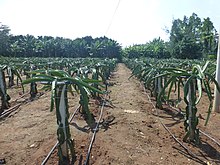
This area has been a center of international trade for centuries. Guangzhou in Guangdong was one of the main Chinese ports on the Maritime Silk Road , starting a few hundred BCE or a few hundred CE according to different historians. Shorter-range trade, such as from Hainan to Vietnam and the rest of Southeast Asia , has also been going on for a very long time.
Along with neighboring East China , this area was the "China Coast" of the 19th century, the region where tea clippers loaded and other trade (including opium) boomed. Both Chinese and European traders made and lost fortunes, and wars were fought over trading rights. A host of "missionaries, mercenaries and misfits" from all over the world poured in while education, production, modernisation, corruption, consumption, and seduction all went on at a furious pace. Today the area is far less wild, but it is still booming and still attracts many foreign residents.
The region has also been the source of much migration. Many overseas Chinese can trace their ancestry to one of these provinces, and Guangdong in particular has descendants more or less everywhere. In any European country, most people of Chinese descent can trace their roots to Guangdong, and the most common style of Chinese food in Europe is Cantonese (Guangdong) food.
Talk [ edit ]
This area of China is linguistically rich, with many mutually unintelligible Chinese "dialects" spoken as well as the unrelated Zhuang language in Guangxi, belonging to the ethnic minority of the same name. The predominant language this region is Cantonese , which is also spoken in nearby Hong Kong and Macau . Other dialects spoken include Hakka , Teochew (spoken in Chaoshan , near the Fujian border) and Hainanese . The area is also home to several ethnic minorities besides the Zhuang, such as the Li people in Hainan, who speak various non-Chinese languages.
As elsewhere in China, Mandarin is the lingua franca . As Mandarin is the language used in schools, most people are bilingual in Mandarin and their local tongue.
Get in [ edit ]
Guangzhou is one of China's main aviation hubs, and is served by flights from all over China, as well as from major cities all over the world. It is also common to fly into the area through Hong Kong or Macau , nearby cities which are also international hubs.
Shenzhen also has a fairly large number of international flights, while there are also much smaller numbers of international flights into Shantou , Haikou , Sanya , Meizhou , Nanning , and Guilin .
Because so many people from this region have immigrated there, the region is particularly well-connected to Southeast Asia . See Discount airlines in Asia for more information.

Get around [ edit ]
As elsewhere in China, there is an extensive rail network. Rail is the main means of inter-city travel for the Chinese themselves, and many visitors travel that way as well. The system now includes fast bullet trains on some routes; unless your budget is very tight, these are the best way to go — fast, clean and comfortable.
All the major cities have airports with good domestic connections; some have international connections as well. See the individual city articles for details.
There is also an extensive highway network, and much of it very good. Buses go almost anywhere, somewhat cheaper than the trains. See the China article for more. Driving yourself is also possible, but often problematic; see Driving in China .
See [ edit ]

- Unique and beautiful mountains, most famously around Guilin but also in Danxiashan
- "The world's workshop" – sprawling factories and dazzling skyscrapers in the Pearl River Delta
- The legacy of overseas Chinese in Kaiping and Taishan
- China's best beaches, most famously Sanya in Hainan
- Historic sites from Guangzhou 's centuries as a maritime trading hub and Dongguan 's involvement in the Opium Wars
Do [ edit ]

The whole coast, and especially Hainan , is well provided with beaches and many areas have facilities for kite surfing, diving or other water-based activities.
This is warm tropical water, though, and dangerous species such as sharks and jellyfish are present in some areas; consult a knowledgeable local before swimming anywhere except on busy beaches. Also, check any rented equipment very carefully before doing any inherently dangerous activities such as SCUBA or hang-gliding; government inspections are non-existent or lax and not all vendors are conscientious.
Eat [ edit ]
Cantonese (Guangdong) cuisine is one of the 'eight famous cuisines' in China. Cantonese food is widespread around the world, the basic style of most Chinese restaurants anywhere. Though true Guangdong cuisine, or Yue (粵) as it is known in China, may contain a few surprises, the essence of the style of cooking will be familiar to most visitors. Hainan is also known for its seafood. Hainan food tends to be lightly seasoned and not as heavy as other regions.
Drink [ edit ]
As anywhere in China, beer, wine, brandy and bai jiu (the local white lightning) are very widely available. See China#Alcohol for discussion.
Some brands are common in this region that are much less so elsewhere in China. The Filipino company San Miguel has breweries in Hong Kong and Guangdong, and their beer is popular among expats and travellers in that region. The Singapore-based firm Asia Pacific Breweries [dead link] have a brewery on Hainan and their brands of beer, Tiger and Anchor, are common all over the island. Hainan also has a number of locally-brewed pineapple-based beers, odd but worth a try.
Stay safe [ edit ]
Humidity is often very high in the summer. Typhoons are possible any time between May and November, with the highest risk in July and August.
Go next [ edit ]
China's relatively new and quite extensive system of fast bullet trains provides connections from this region to the rest of China.
- Branches off this line connect to all the main cities of Eastern and Central China.
- Beyond Beijing, there is a high-speed line into the Northeast.
- The link further south to Zhanjiang and Hainan is due in 2016.
- A line from Guangzhou to Chengdu , via Guilin (a major tourist area) and Guiyang is due to go into service in 2014
Once those are all in service, they will be the most convenient way to leave the region. There are also good connections by regular train, by road or by air from this region to anywhere in China.
See Discount airlines in Asia for flights to Southeast Asia . There are also overland routes to Southeast Asia; the main ones are via Nanning to Hanoi or from Kunming into Northern Laos .
- Has custom banner
- Has mapframe
- Has map markers
- Articles with dead external links
- Has Geo parameter
- Outline regions
- Outline articles
- Region articles
- All destination articles
- Pages with maps
Navigation menu

- China Tours
- Top 10 Tours
- Group Tours
- Tailor-made
- Destinations
- Classic China Tours
- Scenic China Tours
- China Cultural Tours
- Yangtze River Cruises
- Silk Road Adventure
- Tibet Tours
- Yunnan Tours
- Beijing Tours
- Shanghai Tours
- Guilin Tours
- Chengdu Tours
- Zhangjiajie Tours
- China Group Tours 2023
- Beijing Group Day Tours
- Shanghai Group Day Tours
- Guilin Group Day Tours
- Hong Kong Group Day Tours --> --> All Asia Tours Privacy Statement
Our license Number: L-GX-CJ00001
Copyright 2004 All Rights Reserved Top China Travel

China Tours & Vacations

Welcome to China – one of the world's oldest and most enduring cultures; all yours to explore.
The Terracotta Warriors, Forbidden City, the giant panda and the flowing Yangzi – China is home to some of the world’s most remarkable places. And as you venture deep into the cityscapes from Shanghai to Beijing , float past Yangshuo's limestone karsts and explore the tranquil monasteries in Emei Shan and Lhasa, you’ll be struck by how diverse this land can be. The rich tapestries of history, the charm of local villagers, the diversity of regional culinary traditions and sublime natural beauty, all coming together to create an experience like nothing else. Welcome to China – one of the world’s oldest and most enduring cultures; all yours to explore.
Our China trips
Let's create an exclusive trip for your group.
China tour reviews
Filter by rating
China Highlights
Tibet: Beijing to Kathmandu Overland
Explore China
Articles of China
Explore these 7 tea rituals from around the world
Japan or China: Where to travel next?
6 unique places you can stay on an Intrepid Premium trip
Hey kids! 10 awesome family travel experiences that you AND your parents will love
An introductory guide to snacks and street food in China
How to avoid cultural faux pas in Beijing
What to expect when you’re travelling by train in China (and why you should definitely do it!)
Why you should definitely consider a winter adventure in China
China at a glance
Capital city.
Beijing (population approximately 21.5 million)
Approximately 1.4 billion
Renminbi (CNY)
Mandarin, Cantonese and many other dialects
(GMT+08:00) Beijing, Chongqing, Hong Kong, Urumqi
CALLING CODE
Electricity.
Type A (North American/Japanese 2-pin) Type C (European 2-pin) Type I (Australian/New Zealand & Chinese/Argentine 2/3-pin)
Learn more about China
Culture and customs, from ancient cultures....
As one of the world's oldest cultures, China has so much history to observe, taste, admire and learn about. Ancient mythology and spirituality are infused throughout the traditional dance, art, music and literature of China, with many contemporary customs directly attributed to centuries-old traditions.
Much of Chinese philosophy is interwoven with interactions and relationships between people and things – the Five Elements theory of wood, fire, earth, metal and water; the yin and the yang; the Chinese Lunar Calendar and Zodiac – and underpin many rituals and customs still present in China.
Ancient cultures and ruling dynasties of China in times’ past are present in philosophy, religion (Buddhism, Taoism and Confucianism) and customs (tai chi, fengshui, fortune-telling and tea ceremonies). Culturally, China has gifted the world everything from martial arts to mah-jong, and we all continue to enjoy the rich cuisine, delicate art and evocative dance.
...to modern times...
China’s cultural identity is dominated by the Han – the largest ethnic group in mainland China, accounting for approximately 92 percent of Chinese citizens. There are, however, another 105 million people who identify as one of over 50 other ethnic minorities, including the Zhuang (southern China), Hui (northwest China), Uyghur (Central Asia) and Tibetan (Tibet autonomous region). Together, these ethnic groups have constructed a much more diverse China than new travelers may initially be aware of – all with unique customs, longstanding traditions and countless stories to tell. Over 800 million Chinese citizens speak Mandarin while many others use Cantonese, especially along the southeastern coastline. Although both languages may be considered very difficult to learn, it is important to learn at least a few phrases when traveling to show respect to the locals.
...and the balance of the two
While modern China is changing at a rapid pace, much of China still clings to age-old traditions and ways of life. This culture clash is particularly evident when visiting large cities like Beijing that are home to ancient hutongs alongside modern skyscrapers, time-worn temples and glorious World Heritage sites, all found within walking distance of each other. With centuries of dramatic history and ethnic identities key to uncovering the diversity of the country’s people, China remains one of the world's most fascinating places to travel.
History and government
Early history.
As one of the world's oldest civilizations, China has an intriguing history that spans thousands of years. The Yellow River is known as the Cradle of Chinese Civilization as it is thought that what we now know as ‘China’ originated on the banks of this river.
China's early history is dominated by periods of dynastic rule, fragmentation and imperialist expansion, with each dynasty contributing something different to the history books. Construction of the Great Wall of China was thought to have started during the Qin Dynasty, with the Ming Dynasty enhancing the wall at a later stage. The Tang Dynasty is known as a time of prosperity and artistic expression, the Song Dynasty is famed for being a time of scientific and technological discovery, and Kublai Khan's Yuan Dynasty saw an overall population decline that has been attributed to everything from an administration error to the arrival of the Bubonic Plague.
Once the Yuan Dynasty was overthrown by the Ming Dynasty in 1368, population numbers began to increase again and urbanization grew quite rapidly. Private enterprise flourished, with small-scale paper, silk and cotton trading providing trade income to the masses. The following period of rule known as the Qing Dynasty stretched from 1644 to 1911. This is generally seen as a time of rebellion and upheaval with the Taiping Rebellion, Nien Rebellion, Panthay Rebellion and Boxer Rebellion all testing the Qing's ability to rule. Thankfully, remnants of most of these periods of history can be found in China today.
Recent history
The Republic of China was formed in Nanjing in 1912 after a military uprising. Leadership changed hands many times throughout the following years until the People's Liberation Army succeeded in ousting the US-backed Chiang Kai-Shek after a long and bloody battle.
Mao Zedong became Chairman, or leader, of the People's Republic of China in 1949 and China's society was systematically converted to communism. Land reforms and the collectivisation of agriculture significantly altered the structure of society and daily life. Dramatic population, cultural and economic changes led to events that Western societies remember as the Great Leap Forward and the Cultural Revolution. Mao's death in 1976 triggered leadership changes and economic reforms, the impact of which has rippled into the future.
More recently, China has seen Hong Kong and Macau returned from foreign rule and enjoyed a period of increased economic growth. The country basked in the international spotlight as the host city of the 2008 Summer Olympics and with a strengthening economy, wide-scale global influence and dominant rule by the Communist Party of China, China is now one of the world’s global superpowers.
For travelers, China’s rich and engaging history, especially through dynastic rule and its cultural philosophies, has created a country so fascinating, so layered and so rewarding to explore. Opening the first chapter of China’s history book begins the moment you arrive.
Eating and drinking
Whether it’s slurping down a bowl of noodles at a Silk Road street market, having a mouth-numbing Sichuan hotpot in Chengdu or waving down the dim sum trolley at a morning yum cha, you won’t go hungry in China.
Chinese cuisine focuses on color, aroma and taste, and nearly every region and minority group has its own cooking style. Chinese cuisine has traditionally been broken down into eight major schools of cooking: Anhui, Cantonese, Fuijan, Hunan, Jiangsu, Shandong, Sichuan and Zhejiang. They’re also grouped into northern, southern, western and eastern cooking styles.
Rich and hearty northern cuisine – flavored with lots of salt, ginger, garlic and soy sauce – is what fed the emperors. Southern cuisine – particularly from the Cantonese school – is what you’ve likely sampled at your local Chinatown, such as dim sum. Western cuisine brings the heat thanks to ample use of Sichuan peppercorn and piping hot chili peppers, and eastern cuisine tends to be sweeter in flavor and features a wide variety of vegetables, shellfish, fish and other types of seafood.
Dishes to try in China
- Sichuan hot pot Taste a bit of Chinese history by dipping into a fiery Sichuan hot pot filled with meat, vegetables, noodles and chili. While each region in China has different varieties, Sichuan lays claim to the spiciest.
- Cantonese dim sum (Yum Cha) Sitting down to a dim sum banquet is one of Hong Kong's great culinary experiences. Bamboo baskets of salty dumplings and pots of cleansing tea change hands in this traditional feast that will leave you feeling very full.
- Green tea China is home to one of the world's largest tea drinking cultures, with most locals sipping a few cups of tea daily. Green tea may have recently risen in popularity in Western societies, but it’s been used as a medicine in China for thousands of years.
- Peking duck This famous roast duck dish from Beijing dates back to Imperial China. It’s one of the best flavor combinations in the world: succulent slices of duck served between delicate pancakes with green onions and a sweet dark sauce.
- Street snacks A lot of Asia’s best food is found in markets, hole-in-the-wall restaurants and street-side stalls. Think baozi (steamed stuffed buns), jiaozi (dumplings), jianbing (fried chive pancakes), yang rou chan (lamb kebabs) and so much more. China may be famous for giant feasts served on a lazy susan, but don’t dismiss what can be found on a budget.
Learn more about Chinese food
Find out what to drink in China
Geography and environment
Located in east Asia along the coast of the Pacific Ocean, China is the third-largest nation in the world by total land area, behind Russia and Canada . It shares its border with 14 countries including Russia, Kazakhstan and Mongolia in the north, and India, Laos and Vietnam in the south.
Soaring peaks, high plateaus and desert occupy the western half of this vast country. In the southwest, Mount Everest and the Himalayas form the border with India , Nepal and Bhutan. In the north, the Taklamakan and Gobi deserts stretch from west to east along the border with Mongolia. The terrain slopes into broad plains and deltas in the east. Two major rivers flow through central China – the Yellow River in the north and the Yangzi in the south – where rice paddies flourish.
China, as well as 16 other countries around the world, is known as ‘megadiverse’ – a grouped classification of biodiverse countries that contain over 70% of the world’s endemic flora and fauna. China itself is home to over 550 species of mammals, 1221 species of birds, 146,000 types of flora and 10,000 species of fungi.
Despite this, China has a series of challenges in terms of safeguarding its environment and biodiversity. China’s industry is booming and air pollution is on the rise. It has become the world’s largest carbon dioxide emitter and to deal with this, China has become the world’s leading investor in renewable energies and is making a big effort to reduce widespread air pollution in its major cities.
China has a multitude of different shopping experiences, from the massive malls of Beijing to the fashion boutiques of Shanghai and the small village markets that are dotted around the country.
In Beijing, your best bet for shopping is along Wangfujing Street for designer labels, Hongqiao Market for a wide range of pearls and Yaxiu Market for gifts and souvenirs. Nanjing Road and Xujiahui are Shanghai’s shopping hotspots and the eclectic Huaihai Road has been likened to Tokyo’s Harajuku fashion district, so that’s also worthwhile visiting.
Things to buy in China
- Silk As the home of this popular fabric, China’s silk is undoubtedly legendary. It’s been greatly admired by the world for centuries, so don’t leave China without picking some fabric, handmade clothing or a scarf or two.
- Chinese calligraphy art This beautiful art form has been practised in China for centuries. Buy an antique artwork or get a customized piece featuring your name made on the spot.
- Paper cut art This traditional art is a painstaking process that ultimately creates an intricately beautiful result. Associated with Chinese New Year, paper art souvenirs can be found all year round, with designs of flowers, animals and people the most common.
- Chinese knots These traditional, decorative handicrafts are seen as a symbol of health and prosperity and make brilliant gifts for friends back home. The tassel-style gifts are said to ward off evil spirits and are often given as good luck charms during Chinese New Year celebrations.
It's a good idea to check with customs to ensure that you are able to bring certain items back into your home country. Australia and New Zealand generally have strict quarantine laws, especially with food, plant or wood-related products.
Festivals and events
Festivals in China are an integral part of celebrating local cultures and traditions. They are a time for families to return home and gather for a day – or days – filled with food and festivities.
Chinese New Year (Spring Festival)
The most important holiday in the country, Chinese New Year is such a big deal that it’s celebrated over 15 days. The main event is New Year’s Eve, when red decorations are hung all around and people travel home to celebrate. Children receive red envelopes stuffed with cash and fireworks and firecrackers go off at midnight. Lanterns, bracelets, cards and tokens are all coloured red as this is considered to be the color of good fortune.
Lantern (Yuan Xiao) Festival
Though it marks the end of the Chinese New Year celebrations, the Lantern Festival is a festival in its own right that takes place 15 days after Chinese New Year. It’s a fantastic time to be in China as the country lights up with colorful lanterns.
Harbin Ice and Snow Festival
Ever wanted to visit a real-life winter wonderland? Then head to Harbin in January to see massive illuminated sculptures made of snow and ice. Past creations have included the Great Wall (which doubled as an awesome slide), the pyramids of Egypt and even a Disney castle.
Dragon Boat (Duanwu) Festival
Equal parts frantic dragon-boat racing and sticky-rice consumption, this three-day festival – meant to commemorate ancient Chinese poet Qu Yuan – is celebrated all across China. On the fifth day of the fifth lunar month, people flock to waterways to feast on zongzi (rice dumplings) and realgar (or xionghuang) wine as they watch the colorful boats race.
Learn more about festivals in China
Public holidays that may impact travel include:
Chinese New Year
Spring Festival
Qingming Festival
Dragon Boat Festival
National Day
Please note dates of China's public holidays may vary.
China travel FAQs
Do i need a covid-19 vaccine to join an intrepid trip.
Trips from 1 January 2023 onwards
From 1 January 2023, Intrepid will no longer require travelers to provide proof of vaccination against COVID-19 (excluding all Polar trips and select adventure cruises).
However, we continue to strongly recommend that all Intrepid travelers and leaders get vaccinated to protect themselves and others.
Specific proof of testing or vaccination may still be required by your destination or airline. Please ensure you check travel and entry requirements carefully.
Do you need a visa for China?
Visitors from most nations are required to obtain a visa for trips to mainland China. Be sure to apply before leaving your home country – if you don’t, your applications might be denied.
For most travel plans, you will need a single-entry tourist visa valid for 30 days. Generally, a standard 30-day single-entry visa can be issued in four to five business days and at a higher cost for an express application. Once issued, the visa must be used within three months.
For immigration purposes, Hong Kong is not considered part of mainland China and most nationalities, including EU, Australian, US, Canadian and South African citizens, do not require a visa to visit for varying periods of stay.
Please check with your local embassy for specific requirements for Hong Kong and mainland China, as requirements and conditions continuously change. Check with your Chinese embassy or a registered Visa Application Service Centre about what you need to do to apply well before your departure date.
The page is for general information only and may be subject to change. It is your responsibility to obtain relevant visa and travel information required for entry, departure and travel to each country or region you visit on your trip. You should confirm these with the relevant embassies and/or consulates.
Last updated: 20 March 2023
When is the best time to visit China?
From the rugged mountain interior of Emei Shan to the glittering coastal city of Shanghai, China is home to a diverse range of landscapes and climates. We recommend checking out our regional breakdown to help you figure out the best time to visit China.
Tourism is generally at its peak in summer, so if you’re not into crowds, you may want to avoid June, July and August. If you’d still like the weather to be somewhat warm, a shoulder season month like November or May might be best – you’ll usually only need a light jacket or fleece, but the bulk of the crowds are gone.
Is tipping customary in China?
Generally, tipping is not expected in mainland China, although leaving spare change at restaurants and giving a small amount to hospitality staff is becoming more commonplace (although not mandatory). For example, tipping porters and bartenders a small amount is no longer unusual. The culture of tipping is different in Hong Kong, where taxi drivers and restaurants will usually round up the bill, and service staff will generally expect a tip.
What is the internet access like in China?
Internet access is generally good in hotels and tourist areas, but it's limited in rural and remote areas. Some fast food chains, restaurants and cafes have free wi-fi available, but may require a Chinese phone number to receive the login code. The login prompts may also be in Chinese.
Chinese governments and authorities keep strong controls over internet access and many Western websites, including social media and news outlets, are censored. Sites and apps including Facebook, Twitter, Instagram, Google products (YouTube, Maps, Gmail, Drive), WhatsApp, Snapchat and Dropbox, as well as many international news outlets, will not work.
You may wish to download the WeChat app during your visit, which is the country’s most popular method of communication. It’s like WhatsApp crossed with Facebook, kind of.
For many expats and travelers, a Virtual Private Network (VPN) is used to limit this censorship. If you are insistent on using certain websites abroad, look into purchasing a reputable VPN – keep in mind most of the free ones, and some of the paid VPNs will not work. If you do decide to go down this route, still consider what you search for online or access while in China, as some of this content could land you in hot water with authorities if found out.
With all this in mind, you’ve got the opportunity to switch off and enjoy the sights around – that’s one way of looking at it!
Will my mobile phone work in China?
Mobile phone coverage is generally excellent in China's cities, and still very good in remote and rural areas.
If you have an unlocked phone, purchasing a local SIM on arrival is probably the cheapest and most reliable option to use your phone on the go.
If you wish to use global roaming while in China, be sure to contact your service provider to understand how much this will cost, as it's often extremely expensive.
What are the toilets like in China?
Squat toilets are most common in China, though Western-style flushable toilets can sometimes be found in modern hotels and restaurants. Be sure to carry your own toilet paper or tissue and hand sanitiser as these are rarely provided, especially in public places.
Can I drink the water in China?
While water quality is improving, drinking tap water still isn't recommended in China due to the presence of pollution and natural contamination of water supplies.
For environmental reasons, try to avoid buying bottled water. Fill a reusable water bottle or canteen with filtered water. Ask your leader where filtered water can be found; some hotels we stay in may have drinking water available, often boiled to use for tea. It's also advisable to avoid ice in drinks and to peel fruit and vegetables before eating.
Are credit cards widely accepted in China?
Credit cards may work in big vendors in major cities like Beijing, Shanghai or Hong Kong but it's not guaranteed and less likely to work in smaller cities or towns.
WeChat and Alipay are the most prominent online payment methods in China. We strongly suggest you set up either WeChat or Alipay on your device before arriving.
This will require you to link a credit or debit card to the app and also set up a data roaming package so that you can make payments locally. A 3% transaction fee may also be charged for foreign accounts. Please check the terms and conditions when setting up an account.
What is ATM access like in China?
Bank of China or HSBC ATMs are the most widely accessible and reliable. However, it's rare to make cash payments in China nowadays, and even if vendors accept cash, they may not have the right change.
WeChat and Alipay are the most prominent payment methods now. We strongly suggest you set up WeChat or Alipay on your device prior to arriving. This will require you to link a credit or debit card to the app and set up a data roaming package so that you can make payments locally.
A 3% transaction fee may also be charged for foreign accounts. Please check the terms and conditions carefully.
What is the weather like in China?
China is huge – and so its weather is super diverse. Depending on what time of year you visit China and where you go, you can experience unrelenting heat and humidity in summer and thick snow cover throughout winter .
China’s northern regions have hot and dry summers, while destinations on the eastern coastlines and in the south are more humid with a larger chance of monsoon rains and typhoons.
There’s a chance of snow across most of the country; however, this is much more likely in the northern reaches (Beijing and surrounds). Late winter and early spring can often bring a dust storm rolling in from the Gobi Desert to Beijing and northern China. Rainfall in Shanghai and the east coast is abundant between April and September, but almost non-existent for large chunks of the year in Central and Western parts of the country.
Do I need to purchase travel insurance before traveling?
Absolutely. All passengers traveling with Intrepid are required to purchase travel insurance before the start of their trip. Your travel insurance details will be recorded by your leader on the first day of the trip. Due to the varying nature, availability and cost of health care around the world, travel insurance is very much an essential and necessary part of every journey.
For more information on insurance, please go to: Travel Insurance
Is China a safe destination for LGBTQIA+ travellers?
Equal rights have a long way to go in China. The government heavily censors portrayals of same-sex relationships and, up until 2001, homosexuality was considered a mental illness. Same-sex couples are unable to marry or adopt in China, and discrimination laws and legal protections are not equal between LGBTQIA+ and non-LGBTQIA+ identifying citizens.
That being said, China is a relatively hassle-free destination for LGBTQIA+ tourists who travel with discretion. Chinese people are generally tolerant and homophobic-related violence is incredibly rare. Low-key gay scenes/communities can be found in larger cities like Beijing, Shanghai and Hong Kong. While it’s common for friends of the same sex to hold hands, keep in mind any further displays of affection are frowned upon for both same-sex and heterosexual couples.
As with any public display or protest in China, there is much resistance from authorities and the government to any form of mass demonstration organised within China. Various events have been banned in recent years, not because they are promoting LGBTQIA+ rights, but because they are publicly promoting anything at all.
For more detailed and up-to-date advice, we recommend visiting Equaldex or ILGA before you travel.
If you are travelling solo on an Intrepid group tour, you will share accommodation with a passenger of the same gender as per your passport information. If you don’t identify with the gender assigned on your passport, please let us know at the time of booking and we’ll arrange the rooming configuration accordingly. For travellers who do not wish to share a room, most of our tours have the option to pay for an individual room.
Is China accessible for travelers with disabilities?
Intrepid is committed to making travel widely accessible, regardless of ability or disability. That’s why we do our best to help as many people see the world as possible, regardless of any physical or mental limitations they might have. We’re always happy to talk to travelers with disabilities and see if we can help guide them towards the most suitable itinerary for their needs and where possible, make reasonable adjustments to our itineraries.
Accessibility varies in China depending on where you are. Things are improving every year but given the vast size of China and varying rates of growth, you may find old areas are a lot more difficult to travel through than modern cities. In Shanghai, for example, most public transport is wheelchair-friendly, as are a lot of the sites, whereas Beijing is a lot more difficult to navigate.
In Chinese culture, disability has traditionally been seen as something to overcome rather than something to accommodate, which has hampered efforts to improve both cultural acceptance and access. This is changing, which is fortunate not only for travelers, but also for the 80+ million Chinese people living with physical and mental limitations.
If you do live with a visual, hearing or other impairment, let your booking agent or group leader know early on so they’re aware and suitable arrangements can be made. As a general rule, knowing some common words in the local language, carrying a written itinerary with you and taking to the streets in a group, rather than solo, can help make your travel experience the best it can be.
What to wear in China?
What you decide to pack and wear in China will depend on where you are and what time of year it is. The climate across China can vary a lot. Besides the usual lightweight clothing and comfortable walking shoes, you may want to consider packing a reusable dust mask as dust storms are common in certain regions across China.
Is it safe to travel to China?
China is generally a safe country to travel to, as long as you know where you’re going and stay alert. China is visited by travelers from all around the world and is of no danger to any person who understands local cultures and obeys local laws.
In saying this, China’s government does keep quite a tight lid on foreign influences, such as websites and news coverage, with internet censorship and public surveillance a common occurrence all over the country. Demonstrations and protests are prohibited in public places in China, and if you find yourself in one, or you take a photo or video of the event, this could land you in trouble.
How do I stay safe and healthy while traveling?
From Australia?
Go to: Smart Traveller
From Canada?
Go to: Canada Travel Information
From the UK?
Go to: UK Foreign Travel Advice
From New Zealand?
Go to: Safe Travel
From the US?
Go to: US Department of State
The World Health Organisation also provides useful health information.
Does my trip support The Intrepid Foundation?
Yes, all Intrepid trips support the Intrepid Foundation. Trips to this country directly support our global Intrepid Foundation partners, Eden Reforestation Projects and World Bicycle Relief. Intrepid will double the impact by dollar-matching all post-trip donations made to The Intrepid Foundation.
Eden Reforestation Projects
Eden Reforestation Projects are helping to mitigate climate change by restoring forests worldwide; they also hire locally and create job opportunities within vulnerable communities. Donations from our trips support restoration across planting sites in 10 countries around the globe. Find out more or make a donation World Bicycle Relief
World Bicycle Relief provides people in low-income communities with bicycles to mobilize school kids, health workers, and farmers in far-out areas – giving them access to vital education, healthcare, and income. Donations help provide Buffalo Bicycles – specifically designed to withstand the rugged terrain and harsh environment of rural regions – to those who need them most. Find out more or make a donation
- 86-19138970032 (GMT+8 18:00~09:00)

- Beijing Xian Tours
- Shanghai Beijing Tours
- Hong Kong Guilin Tours
- Hangzhou Suzhou Tours
- Kunming Lijiang Tours
- Shanghai Yangtze Cruise Tours
- Chengdu Tibet Tours
- More Short Stay Tours
- China Tours in January
- China Tours in February
- China Tours in March
- China Tours in April
- China Tours in May
- China Tours in June
- China Tours in July
- China Tours in August
- China Tours in September
- China Tours in October
- China Tours in November
- China Tours in December

- High Speed Trains
- China Yangtze Cruise Tour
- Photography
- Desert Adventure
- Ethnic Villages
- Biking Tours
- Kung Fu Tours
- Heritage Sites Exploration
- China Spring Tours
- China Summer Tours
- China Autumn Tours
- China Winter Tours
Notice! 2024 available cruise routes include 4~5 days Chongqing-Yichang(most classic) and 11~12 days Chongqing-Yichang-Shanghai(limited).

- Best-value Yangtze Cruises
- Top Family-friendly Cruise Ships
- Top 3 Luxury Yangtze River Cruises
- Yangtze River Highlights
- Yangtze River Cruise Routes
- Upstream or Downstream?
- Dining & Drinking
- Accommodations
- On-board Activities
- Yangtze Cruise Booking Steps

- Inner Mongolia

- Fanjingshan
- How to Plan Your First China Tour
- How to Plan Beijing Tour
- How to Plan Xian Tour
- How to Plan Shanghai Tour
- How to Plan Guilin Tour
- How to Plan Sichuan Tour
- How to Plan Family Tour
- 2024 China Travel Ideas
- Best Time to Visit China
- What to Pack for Your China Journey
- Make Payment in China
- Updated China Travel News
- Ultimate Chinese Visa Guide
- Chinese Visa Types
- Chinese Visa Requirements
- Do I Need a Visa for China
- Chinese Visa Application
- Chinese Visa Exemptions
- 144-hour Visa Free
- Shenzhen Visa on Arrival
- Hainan 30-day Visa Free
- Embassies & Consulates
- Invitation Letter
- Useful Visa FAQs & Tips
- Entry Regulations
- Baggage Allowance
- Customs Declaration
- Exit Regulation
- How to Book Train Tickets
- How to Collect Train Tickets
- How to Cancel & Alter Train Tickets
- How to Read Train Tickets
- China High Speed Train Types
- Seats Class & How to Choose
- Friendly Facilities on the Train
- The Train Station Departure Process
- Available Food and Drinks on the Train
- Western Toilets on the Train
- Luggage Racks & Baggage Allowance
- Beijing Train Stations
- Shanghai Train Stations
- Guilin Train Stations
- Xian Train Stations
- Chengdu Train Stations
- Hong Kong West Kowloon Railway Station
- Beijing - Xian
- Beijing - Shanghai
- Guangzhou - Shanghai
- Shenzhen - Shanghai
- Chengdu - Xian
- Shanghai - Hangzhou
- Shanghai - Xian
- Chengdu - Chongqing
- Kunming - Lijiang
- Beijing Capital International
- Beijing Daxing International
- Shanghai Pudong International
- Shanghai Hongqiao International
- Guangzhou Baiyun International
- Hangzhou Xiaoshan International
- Chengdu Tianfu International
- Chengdu Shuangliu International
- Xian Xianyang International
- Shanghai - Beijing
- Hong Kong - Shanghai
- Guangzhou - Beijing
- Chengdu - Lhasa
- Shanghai - Guilin
- Shanghai - Sanya
- Travel in Spring Season
- Travel in Summer Season
- Travel in Autumn Season
- Travel in Winter Season
- Weather in January
- Weather in February
- Weather in March
- Weather in April
- Weather in May
- Weather in June
- Weather in July
- Weather in August
- Weather in September
- Weather in October
- Weather in November
- Weather in December
- Top 10 China Destinations
- Top 15 Things to Do
- China World Heritage Sites
- Top 10 Best Natural Beauties
- Top 10 Museums in China
- Top 10 Old Towns & Villages
- Five Great Mountains in China
- Top 10 Monasteries & Temples
- Top 10 Ski Resorts
- Top 10 Beautiful Lakes in China
- 7 Best Beaches in Sanya
- Top 6 Beautiful Waterfalls
- Panda Volunteering
- Having fun on Ice and Snow Festival
- About Us Who We Are Our Team Why Travel with Us Feedback & Reviews Travel Stories Travelers' Gallery Payment Guide Customer Support Contact Us
- Tour Experiences
Destinations
- Travel Guide
Top 10 China Tours and Itineraries for 2024/2025
Whether your first or tenth journey through China, the Middle Kingdom offers endless opportunities for exploration. This vast nation's diversity in historical heritage, cultural influence, architecture, cuisine, and natural landscapes is truly inexhaustible. From the imperial glories of Beijing and Xi'an to the soaring skylines and neon-lit marvels of Shanghai and Hong Kong, the wonders never cease. Venture to Chengdu's panda sanctuaries or the holy Buddhist realm of Tibet. Marvel at Guilin's spectacular countryside vistas or the majestic Yangtze River. Our Top 10 Tours immerse you in China's finest highlights, revealing the most authentic cultures, and enveloping you in the nation's most fascinating scenery - a true treasure trove awaiting your discovery.
- Top hand-picked destinations, favored by thousands of travelers;
- Diverse experience to delight your trip from the beginning to the end;
- You are fully under care and companion ongoing the whole trip;
- All private tour with flexible departure;
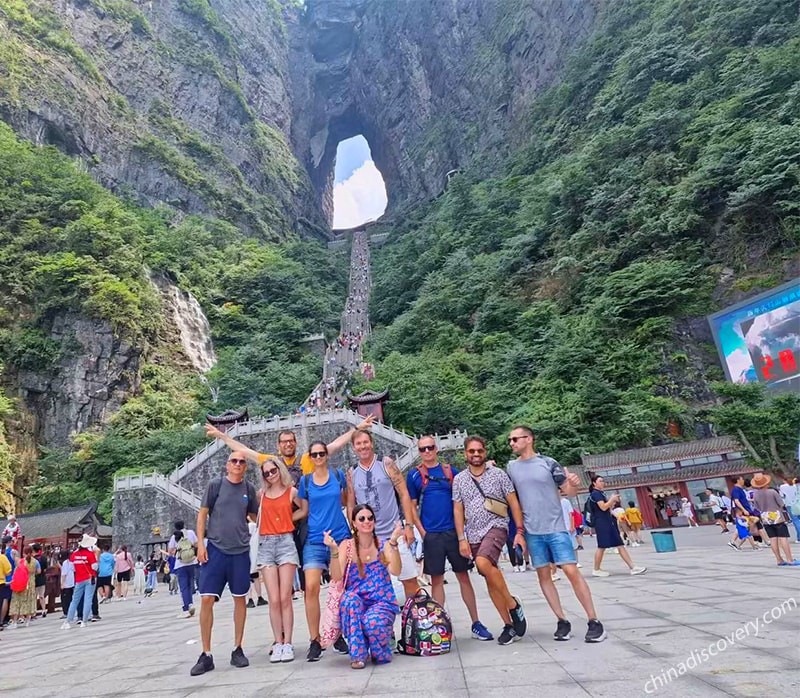
We are one of the few China travel agencies who have kept active and received lots of feedbacks and reviews during pandemic years

Top 10 China Tours - private tour, flexible departure
Below Top 10 China Tours are more recommended as the first-timer China trips which covers the most classic travel destinations in China, such as Beijing, Xian, Guilin, Shanghai, Zhangjiajie, Chengdu, etc. If you want a tailor-made tour, you can use our helpful China Tour DIY Tool . The perfect China tour of your own is only several steps away by telling us your arrival date, favorite destinations or the simple things to do, preferred traveling pace and your group information.
China Golden Triangle
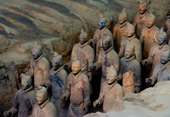
8 Days Best of China Tour
It is most recommended for those who want to visit China for the first time with short days. Great contrast of China’s past and present is the best highlight of this tour. Besides, great accommodation and dinning make your trip more enjoyable.
Destinations : Beijing(4D) | Xian(2D) | Shanghai(2D)
Highlights : Great Wall, Forbidden City, Terracotta Warriors, The Bund, Yu Garden...
from $1,432 / private tour, flexible departure
First Touch of China
10 days classic china tour from beijing.
This tour leads you to top 4 destinations you can’t miss. Experience the stunning diversity and contrasts of ancient tradition and modern fashion, discover the charm of ancient history, and get closer exploration some of the most beautiful scenery under heaven...
Destinations : Beijing(4D) | Xian(2D) | Guilin(2D) | Shanghai(2D)
Highlights : Forbidden City, Terracotta Warriors, Li River, Yangshuo Town, The Bund...
from $1,999 / private tour, flexible departure
Travel China at Leisure
13 days classic china tour with yangtze cruise.
Want to explore China in a leisure way? This is the ideal trip. You will not only visit the Musts to Go – Beijing, Xian, etc, but also gain much fun and leisure time in Guilin. Furthermore, the relaxing cruise on the Yangtze River makes this trip memorable.
Destinations : Beijing(4D) | Xian(2D) | Guilin(2D) | Yangtze Cruise(3D) | Shanghai(2D)
Highlights : Great Wall, Forbidden City, Terracotta Warriors, Li River, Yangtze River, the Bund...
from $2,478 / private tour, flexible departure
Wonders of China Tour
13 days china landscape tour including zhangjiajie.
Beijing, Xian and Shanghai represent the past, today and future of China. While only cultural experience is not fun enough. You should not miss the magnificent landscape of Guilin and Zhangjiajie which are two of most outstanding places to enjoy the natural beauty of China.
Destinations : Beijing (4D) | Xian (2D) | Zhangjiajie (3D) | Guilin (2D) | Shanghai (2D)
Highlights : Great Wall, Yangshuo, Longji Terrace, Zhangjiajie National Park, Terracotta Warriors...
from $2,695 / private tour, flexible departure
Authentic China
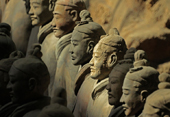
11 Days China Tour from Hong Kong
Take advantage of the convenient international arrival at Hong Kong and departure at Shanghai, then extend your vacation to discover the most authentic experience in other classic destinations - precious cultural relics, stunning landscapes, unique folk customs…
Destinations : Hong Kong(2D)| Beijing(4D) | Xian(2D) | Guilin(2D) | Shanghai(2D)
Highlights : Victoria Peak, Forbidden City, Terracotta Warriors, Li River, The Bund...
from $2,095 / private tour, flexible departure
Panoramic Impression of China
15 days china tour with tibet discovery & panda visit.
This tour gives you the panoramic impression of China - start from east China – Shanghai, and make a turn in the south Guilin, then go to the far west holy land Tibet, via southwest Chengdu, last tour the northern ancient capitals – Xian and Beijing.
Destinations : Shanghai(2D) | Guilin(2D) | Chengdu(2D) | Lhasa(3D) | Xian(2D) | Beijing(4D)
Highlights : the Bund, Li River, Giant Panda, Potala Palace, Terracotta Warriors, Great Wall...
from $3,266 / private tour, flexible departure
Encompassed China Highlights
17 days china paradise tour with tibet & yangtze.
This long vacation package almost sweeps all the best highlights of China in a single trip. It traverses China from north to south, west to east. The attractive diversity of China’s culture and nature embody fully without any reservation in this trip.
Destinations : Beijing(4D) | Xian(3D) | Lhasa(3D) | Chengdu(2D) | Yangtze Cruise(3D) | Shanghai(2D)
Highlights : Forbidden City, Terracotta Warriors, Potala Palace, Giant Panda, Yangtze River, The Bund...
from $3,499 / private tour, flexible departure
Morbidezza of Southern China
9 days east china & mt. huang tour by high speed train.
Experiencing the exquisite Jiangnan-style elegance in Suzhou and Hangzhou, soaking in the excitement of Shanghai's vitality and busyness, being amazed at the four wonders of Huangshan...You will appreciate this deep exploration of China, and also the amazing experience of taking high speed train.
Destinations : Shanghai(2D)| Suzhou (2D) | Hangzhou(1D) | Huangshan(4D)
Highlights : The Bund, Lingering Garden, Suzhou Museum, West Lake, Tunxi Ancient Street, Mount Huangshan...
from $1,572 / private tour, flexible departure
Ancient Silk Road
10 days classic silk road tour from xian.
Start from Xian which was known as the starting point of ancient Silk Road, take a flight to visit Xinjiang (Urumqi, Kashgar and Turpan), then take a high speed train to explore the most legendary part of Silk Road - Dunhuang. Best experience of the frontier landscape and culture.
Destinations : Xian(3D) | Urumqi(1D) | Kashgar(2D) | Turpan(2D) | Dunhuang(2D)
Highlights : Terracotta Warriors, Heaven Lake, Id Kah Mosque, Bazaar, Karez System, Mogao Grottoes ...
from $2,566 / private tour, flexible departure
Leisure China Holiday Full of Fun
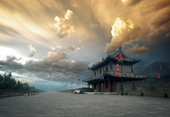
21 Days China Holiday with Yangtze River Cruise Tour
This 21 days' China holiday package tour covers most of the best highlights in China. You can exprience the classical culture of China in Beijing, Xian, Shanghai, also enjoy charming landscape in Guilin and Zhangjiajie. The relaxing Yangtze River Cruise will bring all the fatigue of long trip away from you.
Destinations : Hong Kong(2D) | Guilin(3D) | Chengdu(1D) | Chongqing (1D) | Yangtze Cruise (3) | Zhangjiajie (3D) | Shanghai(2D) | Xian(2D) | Beijing (3D)
Highlights : Li River, Yangshuo, Giant Panda, Zhangjiajie National Par, Three Gorges, Great Wall, Terracotta Warriors...
from $3,795 / private tour, flexible departure

China Trips You May Also Like
Having no idea how to start your China tour? Don’t worry! Why not to start from our popular gateway cities, such as Beijing, Shanghai, Hong Kong or Chengdu? Or take the pick from our travel themes to match your own pace and needs. You can also get inspirations from our hand-picked essential short China trips, even let us customize a trip for you.
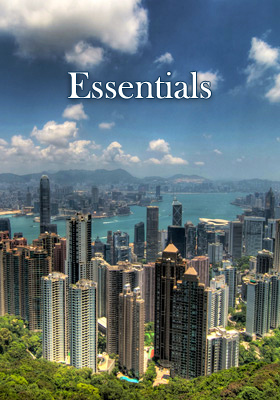
Start planning your tailor-made holiday to China by contacting one of our specialists. Once inquired, you’ll get a response within 0.5~23.5 hours.

- Affordable and valuable price
- 100% tailor-made packages
- Highly rated customers reviews
- Efficient customer support
China Tours
- Top 10 China Tours
- Classic China Tours
- China Tours from Beijing
- China Tours from Shanghai
- China Tours from Hong Kong
- China Tours from Chengdu
- Short China Trips
- Customize China Tour
- China Panda Tours
- Family Tour with Kids
- High-Speed Train Tour
- Silk Road Travel
- Yangtze River Cruise
- Hiking & Trekking Tours
- Photography Tours
- China Minority Travel
- Beijing Shanghai Tours
- Shanghai Yangtze Tours
- Chengdu Jiuzhaigou Tours
- Chengdu Lhasa Tours
- Suzhou Hangzhou Tours
- Guilin & Yangshuo
- Zhangjiajie
“Very good experience”
“WONDERFUL 25 DAYS IN CHINA - PRIVATE TOUR”
“Awesome China tour from northeast to southwest”
Any questions, please email us at: [email protected] or call us at: 86-19138970032 (Monday-Friday 9 a.m. to 6 p.m. GMT+8)
- Terms & Condition
- Privacy Policy
- Customer Support
Copyright © 2011-2024. All rights reserved.
Cookie policy
We use cookies to give you the best experience on our website. Continue using our website means you agree with our cookie policy. For more info, please read here .
12-Day South Xinjiang Adventure Tour
Taklimakan-pamirs adventure.
If north Xinjiang is a beautiful dream, then south Xinjiang is an exciting adventure.
Surrounded by great mountain ranges — Tianshan, Altun, and Kunlun (the Pamirs) — south Xinjiang holds China's biggest desert (the Taklimakan) . Historically, it has cultivated 36 ancient kingdoms and carried the Silk Road's toughest trails .
This 12-day south Xinjiang adventure tour starts from Urumqi. Travel through the Tianshan Mountains. Drive across the Taklimakan Desert. Discover traces of splendid civilizations on the ancient Silk Road. Journey into the incredible Pamirs . And finish in Kashgar.
Tour 'Wow' Points
Drive across "the sea of death" — the taklimakan.
Enjoy a once-in-a-lifetime road trip across the biggest desert in China.
Venture into the Rugged Heartland of the Pamirs
Drive along the China-Pakistan Highway. Feast your eyes on lakes, snowy mountains, and glacier.
Discover Master Pieces of Nature and Culture
Witness the stark desert landforms left by wind and water in the red sandstone of Wensu Grand Canyon, and appreciate valuable murals in nearby grottoes.
Find Traces of Mysterious Lost Kingdoms
There have been 36 ancient kingdoms in the mysterious western region of China. They were important stops on the ancient Silk Road, secluded civilizations in the desert.
Be a Foodie of Xinjiang Delicacies in a Night Market
Taste typical Xinjiang food and snacks, such as lamb shashlik, roast dumplings, roast eggs, or even incredible watermelon pigeon soup!
Learn Xinjiang Craftsmanship with a Local Artisan
Explore a famous street with shops selling handmade crafts such as woodwork, copperware, and traditional instruments. Learn to make a handicraft that was a popular Silk Road product
"Steal" the Business Secrets of a Livestock Merchant
Experience a bazaar that has existed for centuries on the Silk Road — the Kashgar Livestock Market. Learn how to do successful business the Xinjiang way.
Discover real reviews of Highlights Travel Family 's best-rated service across trusted platforms.
Itinerary Quick Look
Here is a suggested itinerary. We are happy to customize a tour according to your interests.
When you land in Urumqi, your personal tour guide will be waiting for you in the arrivals area and will be ready to transfer you to your hotel.
Head for Turpan in the morning. Visit Tuyugou Village in the late afternoon and experience the traditional lifestyle of the Uyghurs.
Discover the Bezeklik Thousand Buddha Caves and view the Flaming Mountain on the way
Visit Emin Minaret in the morning. A beautiful shadow is cast across the walls in the morning sunlight.
Visit the ruins of the ancient city of Jiaohe . This remarkable city was built by digging down from on high instead of building up from the ground!
After lunch, you will venture underground to explore the Karez Well System and discover the wisdom behind Turpan's ancient irrigation system and water supply.
Learn more stories about Turpand and the Silk Road in the Turpan Museum.
Drive southwest and get close to the edge of the Taklimakan Desert. Visit the Bosten Lake which is the biggest indand freshwater lake. It is the site of an ancient kingdom which was an important spot on the ancient Silk Road. Now, the lake is a habitat for some kinds of birds. The south bank of the lake is connected with sands.
Leave Korla for Kuqa, where the ancient Qiuci (Kuqa) Kingdom once thrived. Visit the Ruins of Subashi Ancient Temple in the gravel desert — a representative relic of the ancient Qiuci Kingdom. And then admire the beauties of Kuqa Grand Mosque . Find a combination of traditional Chinese culture and Islamic culture in the buildings.
Continue driving along the edge of the desert. Visit Kezil Thousand-Buddha Caves and witness the exchange and integration of Buddhist culture in the broken but beautiful murals.
Explore Tianshan Grand Canyon , which is a combination of Antelope Canyon, Arizona and the Grand Canyon of Colorado. The red sandstone mountains are a masterpiece of wind and water erosion. You will feel the primitive, wild, and desolate temperament of Xinjiang in this less touristy site.
You will drive across the "Sea of the Death" — the Taklimakan Desert . The vastness of the desert brings out human's tininess and mortality. But the Euphrates poplars will show you the tenacity of life. Wheatgrass squares (China's secret for fixing the sands and reversing desertification) along the road display dividends from the wisdom and hard work of China's people.
When you get to Khotan, you will come back to civilization. Have a relaxing walk on the old street of Khotan . Feel the rich Uyghur flavor when admiring the traditional residential houses on the street.
Explore the local Jade Bazaar . It is interesting to see how people present their jade treasures and how they negotiate to buy the most beautiful stones. The friendly and exciting atmosphere must be very enjoyable to experience. Then trying to look for a real jade stone in Khotan River could be a unique experience.
Trying some traditional snacks in the busy Khotan night market might be another highlight of the day.
Drive from Khotan to Kashgar via Yarkant County. You will stop at Yarkant Palace. The original Yarkant Palace was destroyed when the Dzungar Khanate conquered Yarkent. The palace is an accurate copy according to historical records, and the great buildings, exquisite decoration, and lovely blue color show a rich Islamic flavor.
Then visit the mausoleum of a Yarkant princess, Amani Shah Khan. The soft white of the building and its light blue and light green features might create an image of a gentle and beautiful lady in your mind. You can see poems written by Amani Shah Khan and pictures of traditional Uyghur instruments on the walls of the building.
Explore Kashgar Old Town . Walk from the old city to Handicrafts Street . Go into the shops, touch the semi-finished handicrafts, and test the timbre of exotic musical instruments.
Have a break at an old teahouse that has a history of over 100 years. Many locals gather there to chat, enjoy a tea break, play music, and to dance, often spending a whole afternoon there.
Experience the region's religion in Xinjiang's biggest mosque. Enjoy the beauty of Islamic architecture in a quiet atmosphere.
If it is Sunday, you can also choose to explore the Kashgar Livestock Market . Learn how the local people do their livestock business.
Drive along the China-Pakistan Highway to the Pamirs. Enjoy the seldom-seen scenery of the westernmost point of China.
View the impressive Baisha ('White Sand') Lake and Karakul ('Black Lake'). Snow-capped Muztag Ata and other very tall mountains look like a row of strong guards protecting this land.
Say goodbye to amazing Xinjiang. Your guide and driver will escort you to the airport.
Hotel Selection
—the Icing on the Cake
Boutique hotels are recommended to enrich your travel experience.
Price Includes:
- Private air-conditioned business car with big windows and ample space
- English speaking local guide
- Activities, hotels, and meals listed in the itinerary
- 24/7 helpline for while you are traveling
Tour code: xj-1
Your 1:1 travel consultant will reply within 1 working day.
Number in your group
Adults number (age ≥ 18 years old)
Children number
10-17 yrs old
3-9 yrs old
0-2 yrs old
What's your hotel choice?
I am also available on:
- 11-Day China Family Tour
- 2-Week China Essence and Panda Tour
- 18-day Classic China Tour with Yunnan
- 2-Week Riches of China
- How to Plan a 10-Day Itinerary in China (Best 5 Options)
- 8 Days in China: Top 15 Tours and Itineraries (2024/2025)
- 2-Week China Itineraries: Where to Go & Routes (2024)
- How to Plan a 3-Week Itinerary in China: Best 3 Options (2024)
- China Weather in January 2024: Enjoy Less-Crowded Traveling
- China Weather in February 2024: Places to Go, Costs, and Crowds
- China Weather in March 2024: Destinations, Crowds, and Costs
- China Weather in April 2024: Where to Go (Smart Pre-Season Pick)
- China Weather in May 2024: Where to Go, Crowds, and Costs
- China Weather in June 2024: How to Benefit from the Rainy Season
- China Weather in July 2024: How to Avoid Heat and Crowds
- China Weather in August 2024: Weather Tips & Where to Go
- China Weather in September 2024: Weather Tips & Where to Go
- China Weather in October 2024: Where to Go, Crowds, and Costs
- China Weather in November 2024: Places to Go & Crowds
- China Weather in December 2024: Places to Go and Crowds
Get Inspired with Some Popular Itineraries
More travel ideas and inspiration, sign up to our newsletter.
Be the first to receive exciting updates, exclusive promotions, and valuable travel tips from our team of experts.
Why China Highlights
Where can we take you today.
- Southeast Asia
- Japan, South Korea
- India, Nepal, Bhutan, and Sri lanka
- Central Asia
- Middle East
- African Safari
- Travel Agents
- Loyalty & Referral Program
- Privacy Policy
Address: Building 6, Chuangyi Business Park, 70 Qilidian Road, Guilin, Guangxi, 541004, China
- Election 2024
- Entertainment
- Newsletters
- Photography
- Personal Finance
- AP Investigations
- AP Buyline Personal Finance
- AP Buyline Shopping
- Press Releases
- Israel-Hamas War
- Russia-Ukraine War
- Global elections
- Asia Pacific
- Latin America
- Middle East
- Election Results
- Delegate Tracker
- AP & Elections
- Auto Racing
- 2024 Paris Olympic Games
- Movie reviews
- Book reviews
- Personal finance
- Financial Markets
- Business Highlights
- Financial wellness
- Artificial Intelligence
- Social Media
South Korean, Chinese and Japanese leaders discuss thorny topics and ways to boost cooperation
Leaders of South Korea, China and Japan will meet in Seoul on Monday for their first trilateral talks in more than four years. (AP video shot by Yong-ho Kim)
Chinese Premier Li Qiang, left, waves to media members before getting into a car as Kim Hong-kyun, right, South Korean 1st vice foreign minister, follows behind at the Seoul airport in Seongnam, South Korea, Sunday, May 26, 2024, as the premier arrives for a trilateral meeting. Leaders of South Korea, China and Japan will meet next week in Seoul for their first trilateral talks since 2019. (AP Photo/Lee Jin-man)
- Copy Link copied
Chinese Premier Li Qiang waves as he arrives for a trilateral meeting at the Seoul airport in Seongnam, South Korea, Sunday, May 26, 2024. Leaders of South Korea, China and Japan will meet next week in Seoul for their first trilateral talks since 2019. (AP Photo/Lee Jin-man)
Chinese Premier Li Qiang, second right, is welcomed by Kim Hong-kyun, right, South Korean 1st vice minister, as the premier arrives for a trilateral meeting, at the Seoul airport in Seongnam, South Korea, Sunday, May 26, 2024. Leaders of South Korea, China and Japan will meet next week in Seoul for their first trilateral talks since 2019. (AP Photo/Lee Jin-man)
Japanese Prime Minister Fumio Kishida, left, shakes hands with Chinese Premier Li Qiang before their meeting in Seoul, South Korea, Sunday, May 26, 2024. (Daisuke Suzuki/Kyodo News via AP)
Chinese Premier Li Qiang speaks during a meeting with Japanese Prime Minister Fumio Kishida in Seoul, South Korea, Sunday, May 26, 2024. (Daisuke Suzuki/Kyodo News via AP)
South Korean President Yoon Suk Yeol, right, shakes hands with Japanese Prime Minister Fumio Kishida during a meeting at the Presidential Office in Seoul, South Korea, Sunday, May 26, 2024. (AP Photo/Ahn Young-joon, Pool)
Chinese Premier Li Qiang, center left, is welcomed by Kim Hong-kyun, right, South Korean 1st vice foreign minister, as the premier arrives for a trilateral meeting at the Seoul airport in Seongnam, South Korea, Sunday, May 26, 2024. Leaders of South Korea, China and Japan will meet next week in Seoul for their first trilateral talks since 2019. (AP Photo/Lee Jin-man)
Chinese Premier Li Qiang arrives for a trilateral meeting, at the Seoul airport in Seongnam, South Korea, Sunday, May 26, 2024. Leaders of South Korea, China and Japan will meet next week in Seoul for their first trilateral talks since 2019. (AP Photo/Lee Jin-man)
Japanese Prime Minister Fumio Kishida, second from right, speaks to South Korean President Yoon Suk Yeol, second from left, during a meeting at the Presidential Office in Seoul, South Korea, Sunday, May 26, 2024. (AP Photo/Ahn Young-joon, Pool)
Chinese Premier Li Qiang waves to media members upon his arrival for trilateral meetings at the Seoul airport in Seongnam, South Korea, Sunday, May 26, 2024. Leaders of South Korea, China and Japan will meet next week in Seoul for their first trilateral talks since 2019. (AP Photo/Lee Jin-man)
Japanese Prime Minister Fumio Kishida, third left, holds a meeting with Chinese Premier Li Qiang, third right, in Seoul, South Korea, Sunday, May 26, 2024. (Daisuke Suzuki/Kyodo News via AP)
Chinese Premier Li Qiang waves to media members before getting into a car as Kim Hong-kyun, right, South Korean 1st vice foreign minister, follows behind at the Seoul airport in Seongnam, South Korea, Sunday, May 26, 2024, as the premier arrives for a trilateral meeting. Leaders of South Korea, China and Japan will meet next week in Seoul for their first trilateral talks since 2019. (AP Photo/Lee Jin-man)
Japanese Prime Minister Fumio Kishida speaks during a meeting with Chinese Premier Li Qiang in Seoul, South Korea, Sunday, May 26, 2024. (Daisuke Suzuki/Kyodo News via AP)
South Korean President Yoon Suk Yeol, right, and Japanese Prime Minister Fumio Kishida gesture during a meeting at the Presidential Office in Seoul, South Korea, Sunday, May 26, 2024. (AP Photo/Ahn Young-joon, Pool)
South Korean President Yoon Suk Yeol, left, and Japanese Prime Minister Fumio Kishida move their positions during a meeting at the Presidential Office in Seoul, South Korea, Sunday, May 26, 2024. (AP Photo/Ahn Young-joon, Pool)
SEOUL, South Korea (AP) — The Japanese and South Korean leaders raised sensitive topics like Taiwan, North Korea and the South China Sea as well as ways to boost cooperation when they individually met China’s premier Sunday on the eve of a fuller trilateral meeting.
It was unclear how serious discussions the three leaders had on those thorny issues, which are not among the official agenda items for Monday’s three-way gathering in Seoul, the first of its kind in more than four years.
No major announcement is expected from the meeting, but observers say that just resuming the highest-level talks among the three Northeast Asian neighbors is a good sign and suggests they are intent on improving relations. Their trilateral meeting was supposed to happen annually but it had stalled since the last one in December 2019 because of the COVID-19 pandemic and complex ties among the three countries.
After meeting Chinese Premier Li Qiang, Japanese Prime Minister Fumio Kishida told reporters that he expressed serious concerns about the situations in the South China Sea, Hong Kong and China’s northwestern Xinjiang region. He said Japan is closely monitoring developments on self-governed Taiwan.
He referred to China’s military assertiveness in the South China Sea, clampdowns of pro-democracy movements in Hong Kong and human rights abuses against minorities in Xinjiang. Last week, China also launched a large military exercise around Taiwan to show its anger over the inauguration of the island’s new president who refuses to accept its insistence that Taiwan is part of China.
During a separate meeting with Li, South Korean President Yoon Suk Yeol, on his part, asked China, as a permanent member of the U.N. Security Council, to contribute to promoting peace on the Korean Peninsula, while speaking about North Korea’s nuclear program and its deepening military ties with Russia, according to Yoon’s office.
Yoon’s office said Yoon and Kishida in their separate meeting expressed worries about North Korea’s nuclear program and agreed to strengthen their cooperation with the United States.
South Korea, Japan and the U.S. have long urged China — North Korea’s major ally and economic pipeline — to use its leverage to persuade the North to abandon its nuclear ambitions. But China is suspected of avoiding fully enforcing U.N. sanctions on North Korea and sending clandestine aid shipments to help its impoverished neighbor stay afloat.
The three leaders also discussed how to bolster economic and other cooperation.
Yoon and Li agreed to launch a new South Korean-Chinese dialogue channel involving senior diplomats and defense officials in mid-June. They also agreed to restart negotiations to expand the free trade agreement and reactivate dormant bodies on personnel exchanges, investments and other issues, according to Yoon’s office.
Chinese state media reported Li told Yoon that the two countries should safeguard the stability of their deeply intertwined industrial and supply chains and resist turning economic and trade issues into political and security-related issues.
Kishida said he and Li reaffirmed Japan and China will seek progress on various areas to promote mutually beneficial relations. Kishida and Yoon also said they agreed to further strengthen ties, which have warmed significantly since last year following an earlier setback over issues related to Japan’s 1910-45 colonial rule of the Korean Peninsula.
South Korean officials said that a joint statement after Monday’s trilateral meeting will cover the leaders’ discussion on cooperation in areas like people-to-people exchanges, climate change, trade, health issues, technology and disaster responses.
The three Asian nations are important trading partners and their cooperation is key to promoting regional peace and prosperity. They together make up about 25% of global gross domestic product. But the three countries have been repeatedly embroiled in bitter disputes over a range of historical and diplomatic issues originating from Japan’s wartime atrocities. China’s rise and a U.S. push reinforce its Asian alliances have also significantly impacted their three-way ties in recent years.
Experts say South Korea, China and Japan now share a need to improve ties. South Korea and Japan want better ties with China because it is their biggest trading partner. China, for its part, likely believes a further strengthening of the South Korea-Japan-U.S. cooperation would hurt its national interests.
China, meanwhile, has always sent its premier, the country’s No. 2 official, to the trilateral leaders’ meeting since its first session in 2008. Observers say China earlier argued that under then-collective leadership, its premier was chiefly in charge of economic affairs and best suited to attend the meeting, which largely focuses on economic issues.
But they say China may face more demands for President Xi Jinping to attend because he has concentrated power in his hands and defied the norms of collective leadership.
Associated Press writers Mari Yamaguchi in Tokyo and Simina Mistreanu in Taipei, Taiwan contributed to this report.
We've detected unusual activity from your computer network
To continue, please click the box below to let us know you're not a robot.
Why did this happen?
Please make sure your browser supports JavaScript and cookies and that you are not blocking them from loading. For more information you can review our Terms of Service and Cookie Policy .
For inquiries related to this message please contact our support team and provide the reference ID below.
FLASH SALE💥 Book now for up to 60% off!
China Tours & Trips
- Yangtze River Cruises
- Great Wall of China
- China Group tour
- China Budget
250+ China tour packages with 452 reviews
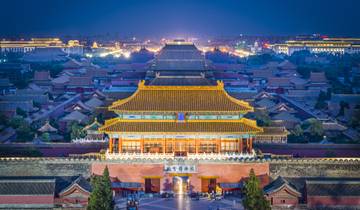
- In-depth Cultural
- Christmas & New Year
Discover China's Silk Road - 11 Days Private Tour
The drivers were punctual, the lodging was tidy, the staff was nice and friendly, and the meals were good.
- Book With Flexibility This operator allows you to rebook your dates or tours with them for free, waiving change fees.

- Train & Rail
- Sightseeing
China Highlights
great trip, a lot of variation in this very compact overview of China. I will go back

6- Days Classic China Tour - Private Tour
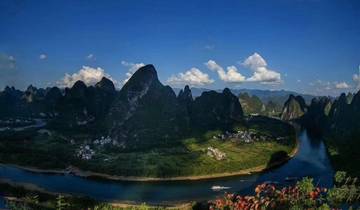
The Essence of Guilin
Great introduction to Guilin and Yangshou. Highly recommended for a introduction of a beautiful part of China.

8-Day Small Group China Tour to Beijing, Xi'an and Shanghai
Learnt not only about history but culture and language today. Felt very safe even when venturing out alone around cities without guides.
- 10% deposit on some dates Some departure dates offer you the chance to book this tour with a lower deposit.

11-Day Small Group China Tour to Beijing, Xi'an, Guilin and Shanghai
The two girls Tina in Beijing and Celine In Xi'an were amazing. The food was good and the hotels were 5 star really.
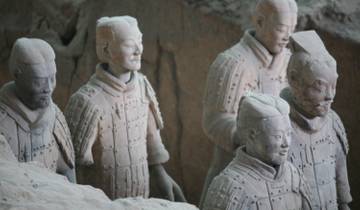
China Delights Small Group Tour
The Great Wall at Mutianyu (Beijing) we took the chair lift option which meant we could ride the toboggan back down.
Looking for tours beyond just China?
Explore tours with itineraries going through multiple countries, including China.
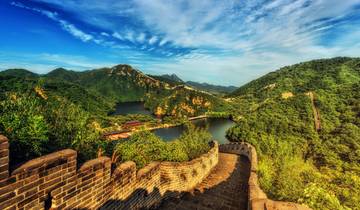
Great Wall & Warriors - 10 days
The tour ended up being better even than I expected.

11 Days China Natural Wonders Small Group
TCT looked after us very well, collected from airports and stations without issues. The itinerary was well put together, fitted a lot in without being exhausting.
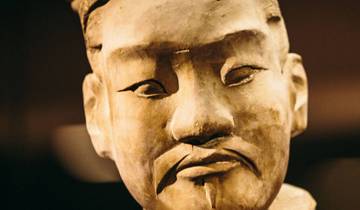
China Express - 8 days
This is a well planned and well-run trip. On The Go's partner in China has all the details planned out well in advance.

China Express
The hotel where we were moved to had no record of us. This defeats the purpose of booking through an agent.

7 Days Lhasa To Shigatse and Namtso Group Tour
I love this trip so much! It is a lifetime experience I will never forget. When we look out from the window of the nomad tent, breathtaking!
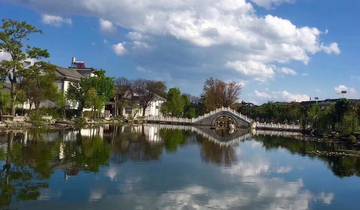
Wild Yunnan 8D: Kunming-Dali-Lijiang- Shangri-La
The whole itinerary was very good scheduled and not to packed, so we had time to stroll around the cities by ourselves as well.
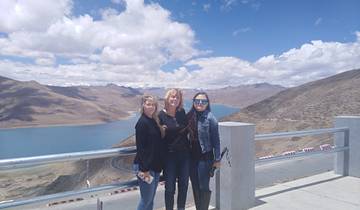
6 Days Lhasa Gyantse Shigatse Group Tour
I have arrived home safe and sound and wanted to let you know that we had a FANTASTIC time in Tibet.

- Food & Culinary
Chinese Cuisine & Culture
The selected sightseeing destinations were very interesting. I felt very well looked after and can only recommend this trip.
What people love about China Tours
The general preparation and organization were excellent. The drivers were punctual, the lodging was tidy, the staff was nice and friendly, and the meals were good. Ms. Evelyn, our travel consultant, kept us informed about schedules and provided daily updates through WhatsApp, eliminating any concerns. We would choose their services again.
Extremely disappointed that we were not informed of the hotel change at the beginning of the trip. I think it would be beneficial to change the group meeting either early afternoon or after dinner so that people can see the Shanghai skyline at night For the sleeper train book whole section and then split the price so you can be with people you know. Sunny was a great guide. She was very informative, helpful and just an all around lovely person who allowed us to appreciate Chinese culture and hospitality.
Excellent tour! Very well organised, includes everything that is necessary and I felt treated like a VIP guest all the time! My guide - Yunhua - bent over and backwards to make my trip unforgettable and he also arranged with great efficiency all the extra activities I was asking for (last minute)
Top operators

"We enjoyed the sites and local ethnic and cultural experiences along with the educational exposure we obtained. We enjoyed the personal touch and attention to detail by most of our tour guides. We can tell some tour guides are more passionate and more experienced than others and that can make a difference. For some of the tour guides that struggle with the English language should be reconsidered as a tour host because they lacked either the experience or attention to detail that many more seasoned guides have that differentiated them and made the experience less desirable. Overall, the attention to our safety and providing us an experience of a lifetime was worth it.
Realistic Asia is an expert in:
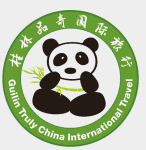
"I had a wonderful time! Guides were very accommodating and knowledgeable. Helped translate for me on several occasions! Tour has a very relaxed pace. Highly recommend.
Truly China Travel is an expert in:

"As a couple surprised by an fantastic individual tour by three very articulate guides and proficient drivers around Beijing, Xian and Shanghai. Learnt not only about history but culture and language today. Felt very safe even when venturing out alone around cities without guides. Our only issue was we could not get internet to connect but that is going to be more us being technophobic. However so supported by guides that not required.
TravelChinaGuide Tours is an expert in:
China Destinations
- Western China (165)
- Southern China (125)
- Great Wall of China (43)
- Northern China (42)
- Sichuan (27)
- Yunnan (23)
- Xinjiang (19)
- Guangxi (19)
- Silk Road (15)
- Gobi Desert (9)
- Guangdong (8)
- Guizhou (6)
- Southern Mongolia (5)
Travel Styles
- Small Group (253)
- Budget (57)
- Luxury (39)
- Singles and Solo (430)
- For Couples (94)
- Seniors (264)
- Group (480)
- Family (403)
- Personalized (348)
- In-depth Cultural (346)
- Partially Guided (308)
- Fully Guided (297)
- Explorer (250)
- Private (133)
- Active (118)
- Hiking & Trekking (29)
- Intl. Flights Included (18)
- Coach / Bus (17)
- River Cruise (17)
- Train & Rail (8)
- Bicycle (6)
- 3 Day Tours (30)
- 7 Day Tours (126)
- 10 Day Tours (127)
- 2 Week Tours (143)
- 3 Week Tours (75)
- 4 Week Tours (9)
- Summer 2024 (482)
- Fall / Autumn 2024 (488)
- Winter 2024 / 2025 (354)
- Spring 2025 (331)
- Spring 2026 (67)
- June 2024 (407)
- July 2024 (458)
- August 2024 (461)
- September 2024 (480)
- October 2024 (474)
- November 2024 (400)
- December 2024 (348)
- January 2025 (290)
- February 2025 (271)
- March 2025 (296)
- April 2025 (303)
- May 2025 (301)
China Tours starting in
- Starting in Beijing (205)
- Starting in Shanghai (49)
- Starting in Lhasa (40)
- Starting in Chengdu (31)
- Starting in Kathmandu (26)
- Starting in Hong Kong (23)
- Starting in Urumqi (19)
- Starting in Guangzhou (17)
- Starting in Xi'an (15)
- Starting in Kashgar (11)
- China Travel Guide | All You Need to Know
Discover TourRadar
- Indonesia Tours
- Thailand Tours
- India Bicycle tours
- Portugal Luxury tours
- Aegean Islands Budget tours
- Australia/Oceania October 2024 tours
- Best 10 Day Ireland Itineraries (with Reviews)
- Skip to main content
- Keyboard shortcuts for audio player
At a conference in Singapore, countries make competing claims to the South China Sea

Scott Simon
Simmering tensions over the South China Sea are front and center during an annual security conference in Singapore this weekend, where there's dueling rhetoric from China and the Philippines.
Copyright © 2024 NPR. All rights reserved. Visit our website terms of use and permissions pages at www.npr.org for further information.
NPR transcripts are created on a rush deadline by an NPR contractor. This text may not be in its final form and may be updated or revised in the future. Accuracy and availability may vary. The authoritative record of NPR’s programming is the audio record.
I went on a 2-week safari in South Africa's famous Kruger National Park for just $50 a day
- I went on an epic two-week safari in South Africa's famous Kruger National Park for about $50 a day.
- I camped beneath the stars and saw elephants right from my tent.
- Driving our own car, camping, and preparing our own food saved us money.

The idea of a South African safari often conjures up images of five-star lodges and luxury game drives — but a holiday in the bush doesn't have to be out of reach for travelers on a tighter budget.
According to a data analysis from Go2Africa , the average traveler heads on South African safaris with a medium-high budget, meaning they spend $5,500 to $6,000 on a trip, an increase from last year.
But, on a recent trip, I found that I was able to have an incredible two-week safari trip in Kruger National Park for about $50 a day.
Here's how I did it and how travelers can save money when planning their safari.
I saved by buying an annual pass
The biggest savings at Kruger National Park can come from buying a Wild Card, an annual pass that gives you a year of access to 80+ parks in southern Africa, including Kruger.
The Wild Card is discounted for South Africans but it cost me 3,780 rands, or about $200, as a foreigner.
Without a Wild Card, I would've had to pay over 486 rands a day to visit Kruger, meaning this pass pays for itself in just over a week.
Overall, my pass came to about 270 rands a day for the two-week trip.
We also stayed in one of Kruger's many rest camps
One of the most immersive ways to experience Kruger is by camping in the South African bush. We saw elephants near our camp and woke up to the sounds of warthogs and hyenas in the distance.
We live in South Africa , so it was easy enough to bring our own camping gear, though travelers can rent a tent, sleeping bags, chairs, and cooking basics from nearby rental companies for a few thousand rands for two weeks.
Kruger National Park has a range of rest camps for different budgets and preferences, whether you prefer to use your own tent or stay in a bungalow with your own kitchen and bathroom.
Related stories
Prices also vary depending on the season, so it's wise to avoid really busy months, like September and December. I found that around mid-January to mid-March, two people can camp at Punda Maria, one of Kruger's cheapest camping options, for just 285 rands a night. During high season, prices go up by about 100 rands per night.
My husband and I visited during a less busy season. We camped at Maroela Satellite Camp and Crocodile Bridge Rest Camp for 331 to 349 rands a night.
Cooking our own food saved us money …
We chose to prepare our own meals and braai (a type of South African barbecue) beneath the stars.
Fortunately, most campsites have plug points, braai stands, shared bathrooms, shared kitchens, and shops selling everything you need to braai.
The park also has restaurants and coffee shops scattered throughout it, which is helpful for anyone who wants to purchase food and drinks without leaving the property.
But there's nothing quite like braaiing beneath the stars, watching for the occasional hyena along the fence line.
… and so did doing a self-driving safari
If you don't have your own car, you can rent a sedan for just over 4,000 rands for two weeks. Fortunately, though, there are enough tarred roads in Kruger that you don't need a special 4x4 to enjoy the park.
We ended up self-driving our own car in Kruger National Park, which allowed us to choose our own adventure and be our own guide.
Rest camps have sighting boards on which visitors pin their major animal sightings from that day and the previous day. This makes it easy to follow trends and choose where to search first. There's also an app where visitors post their sightings.
On our last self-drive safari in Kruger, we saw cheetahs and all the Big Five (leopard, elephant, rhino, lion, and African buffalo).
Overall, our trip was affordable and dreamy
We saved money throughout our trip and managed to go on a two-week safari in Kruger National Park for just under $50 a day per person.
This price includes two Wild Cards, petrol for our vehicle, and our camping fees and expenses — and our trip was well worth it.
Watch: A single trail takes hikers to 10 waterfalls near Portland, Oregon — and you can walk it in less than a day
- Main content

COMMENTS
The Pearl River stretches for 1,376 miles (2,214 km from Xi Jiang to the South China Sea. It's the third-longest river in China and the second-largest by volume. The most famous portion of the Pearl River flows through the heart of Guangzhou, and the waterfront is home to many of the city's top attractions. More. #4.
10. Lugu Lake [SEE MAP] This idyllic lake sits nearly 2,700 meters (9,000 feet) above sea level. To get here, you'll have to ascend an ancient switchback road, and the first site of the lake will leave you breathless. Forested hills slope out of pristine waters while small towns dot the shores.
Maasai Mara Safari. Nordic / Scandinavia Self Drive tours. Pharaohn Tours tours. Four Corners tours. MW Tours tours. Gokyo Valley Trek March 2025 tours. Browse 158 tours from the best tour operators in Southern China with 71 reviews visiting places like Shanghai and Beijing. Compare & book now!
Tours to Southern China also mean a happy exploration of Chinese culture as there are various mystery minorities living in South China such as Yunnan, Guizhou, and Guangxi . With mild weather compared with Northern China , Southern China is a year-round travel destination suitable for travelers of all ages.
Plan a wonderful trip with our Southern China travel guide. The most comprehensive tourist guide for Southern China, China with advice on things to do and see, places to visit and more. ... about 2km (1¼ miles) south, is the Overseas Chinese Museum (Huaqiao Bowuguan), with an outstanding collection of pottery and bronzes gathered with the help ...
A: The best tours in Southern China according to Viator travelers are: 4-Day Zhangjiajie Tour to All Highlight Attractions with VIP Lift. 2-Day "Best Of Zhangjiajie"-Avatar World & Tianmen Mountain Tour. One Day Zhangjiajie Tour to Avatar Mountain and Glass Bridge.
Geographical definition of South China. The Southern part of China is generally everything, which is situated south of Yangtze River. That's how the Chinese think about this part of their country- they call it "Nan Fang" (南方), which means "South Side" and consider Yangtze (Chang Jiang) River as a divider between the South and the North (although it is unclear whether some big ...
The best outdoor activities to do in Southern China are: Guilin: Classic Private Full-Day Tour. 4 Star luxury Li River Cruise from Guilin with buffet lunch. Hong Kong: Go City All-Inclusive Pass with 20+ Attractions. Guilin: Li River Cruise & Sightseeing Tour.
Excellent - by Cheryl. 2 Tours in Southern China. Tour length. Price per day. From 10-12 days. From $347. Choose from the best tour companies in Southern China. Find the right tour operator for your trip to Southern China, and read 11650 reviews from our customers.
Best Time To Visit Southern China. The best time to visit Southern China, China is during the spring (March to May) and autumn (September to November) seasons. During these times, the weather is mild and pleasant, with comfortable temperatures ranging from 15°C to 25°C (59°F to 77°F). The scenic landscapes of Southern China, including the lush greenery and blossoming flowers, are at their ...
Thrilling Ha Giang Loop Motorbike Tour Via Quan Ba, Dong Van And Du Gia. 5.0 (1 review) Ha Giang Loop Motorbike Tour to Dong Van was an experience that surpassed all expectations. Destinations. Ha Giang, Quan Ba +4 more. Age Range. 18 to 70 year olds. Country Region.
Discover the scenic south of China and the Yunnan province for the karst landscapes of Guilin & Yangshuo and the dramatic Tiger Leaping Gorge plus lots more. (US) tel:1-866-606-2960
About this Journey. Yunnan, which literally means "South of the Clouds," is home to some of the most diverse cultures, ecology, and landscape in China. With verdant low-lying valleys, spectacular white-capped mountains, rustic towns and villages and vibrant ethnic minority communities, Yunnan has long inspired both poets and travelers.
With minorities customs and booming trading situation, Southern China Tour will let you see the most kinds of local cultures in China, Yunnan, the southern gate of China to southeastern Asia, entertains you with its unique and mysterious minority atmosphere. Guizhou, the dwelling of Miao and Dong people, entertains you with its ethnic songs and ...
1 Guilin, main city of a major tourist area with incredible karst mountains. 23.13 113.26. 2 Guangzhou, formerly known in Europe as Canton, is the capital of Guangdong, historically Southern China's greatest city, and the third largest city in China. 20.02 110.32.
9 Days Southern China Tour. Guangzhou, Guilin, Shenzhen, Hong Kong. Traveler Reviews. Tour Code: TCT-Classic-08. Tour Type: Private Tour. Tour Highlights: Covering the most classic tourism cities of southern China. Reasonable price, awesome private trip and service beyond your expectation. Hand-picked scenic spots combined with fine-designed ...
China Tours might not be very known in the USA, but they exceeded our expectations. Date of experience: May 2024 • Couples. Jennifer Z wrote a review 25 May 2024. Easy and Good Guides. My husband, a friend, and I took the 8-day Beijing-Xian-Shanghai small group tour- no shopping stops tour departing May 27, 2024. We were the only ones on the ...
China Highlights. Eric · Traveled May 2024. The Intrepid tour to China was a phenomenal experience. Over eight days, we explored Shanghai, Xi'an, and Beijing, marveled at the Terracotta Warriors, walked the Great Wall, and toured the Forbidden City. Our tour leader, Jay, was exceptional, enhancing our journey with his expertise and enthusiasm.
Top 10 China trips & itneraries highly recommended by travel experts and our satisfied customers. Book the best China tours at a very competitive price. Tailor-made Tour Package Refundable Quick Response 3,750+ comments ... It traverses China from north to south, west to east. The attractive diversity of China's culture and nature embody ...
China Natural Wonders Discovery. 2-Week Beijing - Xi'an - Zhangjiajie - Guilin/Yangshuo - Shanghai Tour. The best choice for nature lovers. Witness the Hallelujah Mountains. View More. Family Happiness. 11-Day Beijing - Xi'an - Guilin - Shanghai. Top family itinerary. Experience China's countryside life together.
Surrounded by great mountain ranges — Tianshan, Altun, and Kunlun (the Pamirs) — south Xinjiang holds China's biggest desert (the Taklimakan). Historically, it has cultivated 36 ancient kingdoms and carried the Silk Road's toughest trails. This 12-day south Xinjiang adventure tour starts from Urumqi. Travel through the Tianshan Mountains.
In 2011, Matthew, then a junior official in one of China's most powerful finance ministries, treated himself and his bride to a two-week honeymoon at the resort destination of Maui, in the ...
The Pearl River stretches for 1,376 miles (2,214 km from Xi Jiang to the South China Sea. It's the third-longest river in China and the second-largest by volume. The most famous portion of the Pearl River flows through the heart of Guangzhou, and the waterfront is home to many of the city's top attractions. More
Updated 6:58 AM PDT, May 26, 2024. SEOUL, South Korea (AP) — The Japanese and South Korean leaders raised sensitive topics like Taiwan, North Korea and the South China Sea as well as ways to boost cooperation when they individually met China's premier Sunday on the eve of a fuller trilateral meeting. It was unclear how serious discussions ...
China reported 82 million tourist arrivals last year — returning to about 56% of the 2019 level, before the pandemic shuttered mainland borders — according to the country's National Bureau ...
8-Day Small Group China Tour to Beijing, Xi'an and Shanghai. Igor Titushkin 2 Jan, 2024. 5. This tour is the greatest China esperience! All guides go above and beyond to immerse you in the ancient China history, local culture, natural wonders. Absolutely professional and courteous service, best accomodations, balanced time and activities for ...
Simmering tensions over the South China Sea are front and center during an annual security conference in Singapore this weekend, where there's dueling rhetoric from China and the Philippines.
Megan Gilbert. I went on an epic two-week safari in South Africa's famous Kruger National Park for about $50 a day. I camped beneath the stars and saw elephants right from my tent. Driving our own ...
Zelensky's struggles in Asia are not contained to China. For a host of reasons, Ukraine's cause has failed to generate in Asia the same sort of emotional, existential angst that it has in much ...